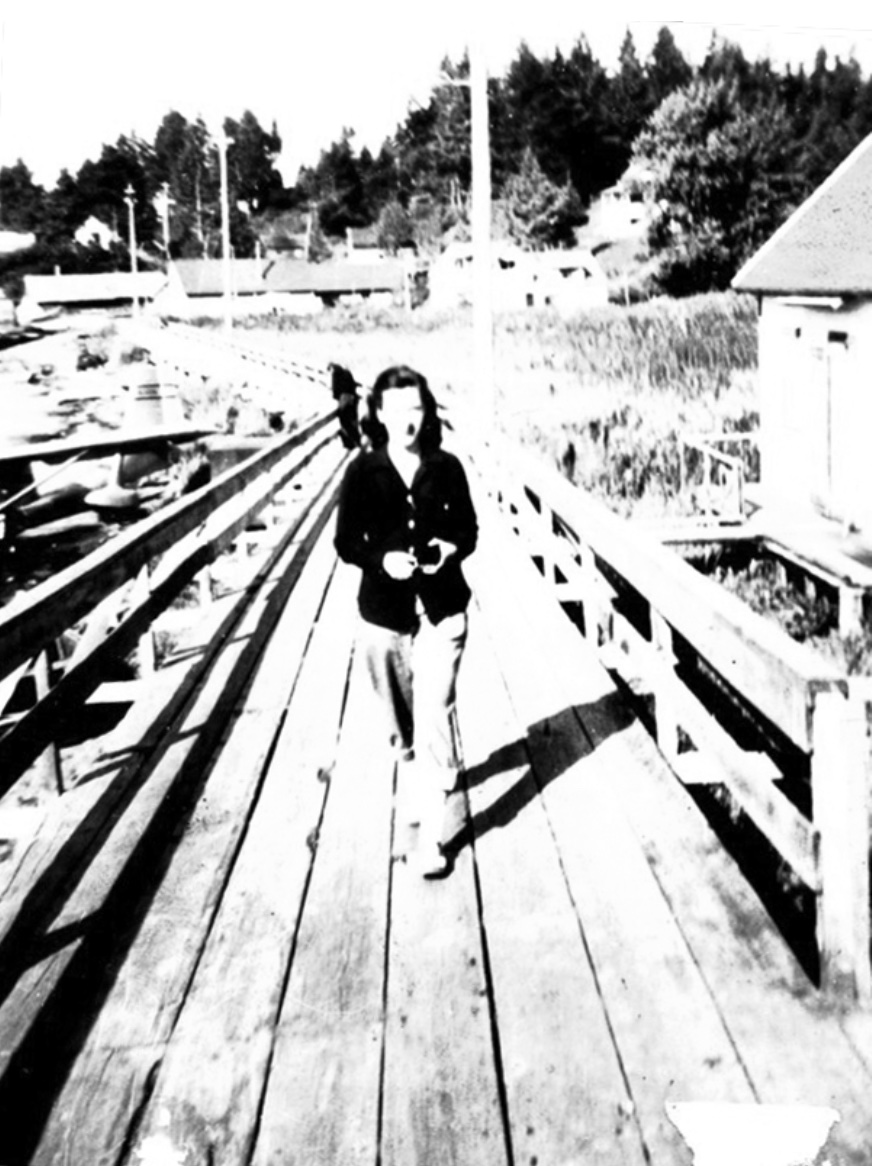

Rufas Bowen’s Cabin. My great uncle Rufas Bowen’s cabin was at the end of the graveyard with the boardwalk above his cabin. It went up and over a little hill that we called Kirby’s Hill. Doctor Kirby lived there and had his office in his home.
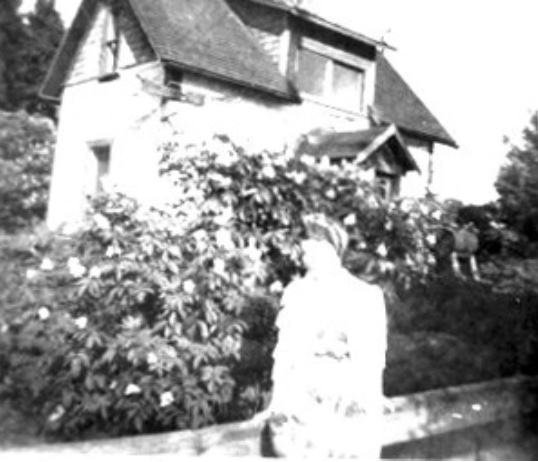
Dr. Kirby. Before we had a hospital, Dr. Kirby was our only doctor that I remember. He was a roly-poly man that lived on the boardwalk near Auntie Florence’s. He always had liquor on his breath. Once while playing with a little kid by the Elvaas house, I cut my knee on a bottle. I remember crying all the way to the doctor’s (I had to walk) and it was at the other end of town. Dr. Kirby poured straight rubbing alcohol on my knee and, boy, did it hurt.
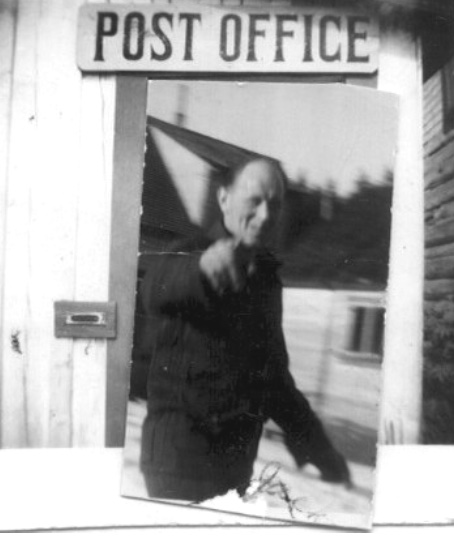
Shrimp Plant. The walk went down past Chambers, then past a small crab and shrimp plant, where I worked for a while cleaning hot shrimp. I think I ate more than I cleaned because we got to weigh them first and mark our weights down.
Post Office. The Post Office was on the hill side of the walk. It was very small and was connected to the Englishes’ home, which I believe was built of logs. The Englishes ran the Post Office. I worked for Mrs. English once cleaning her house. Their children were Arthur and Midge.
Arthur had a movie projector he set up in a small room at his place and we’d all pile in and sit on the floor watching movies, all in black and white.
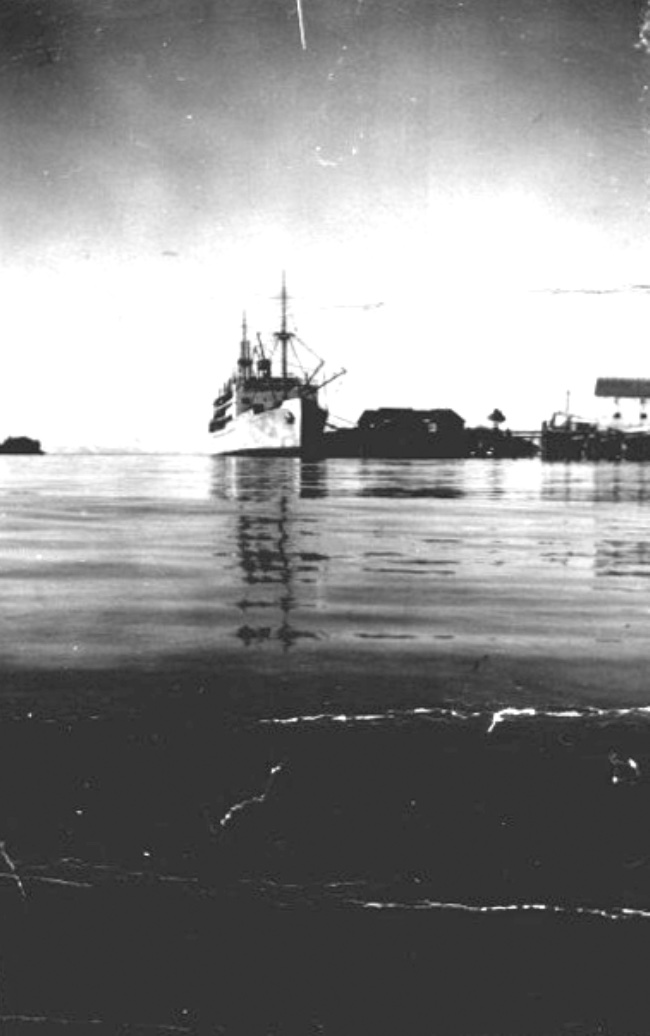
Andersons’ Dock. The boardwalk continued past the oil tanks and oil dock that the Andersons owned. The big ships tied up at the dock, but the cannery boats had their own docks. The passengers coming and going had to walk out the long walk to the dock as we had no cars then. This was a job if you carried too much luggage.
The ships that came in to Seldovia were to us so big compared to our little dock. We got ships only about every three months. One of the ones that I remember most was the SS Denali. It was a big event when any big ship came in, as someone we knew was always coming or going. Everyone who wasn’t working or who could get off raced to the dock. Also all the fresh produce and store supplies came by ship. Many times while we were working in the canneries and the ship came in, even if it was midnight break, we would all race to the dock and even go aboard to the kitchen where the cooks always treated us to applies and goodies. No one ever scolded us or tried to stop us. Maybe it was because no one but us knew that we all did this.
As soon as the supplies were put on the dock and got to the stores, everyone would rush to the stores to buy the fresh fruit and vegetables; they never seemed to last more than one day. I loved to watch the ships go out, because they played Hawaiian music, and everyone waved on the ship and on the dock.
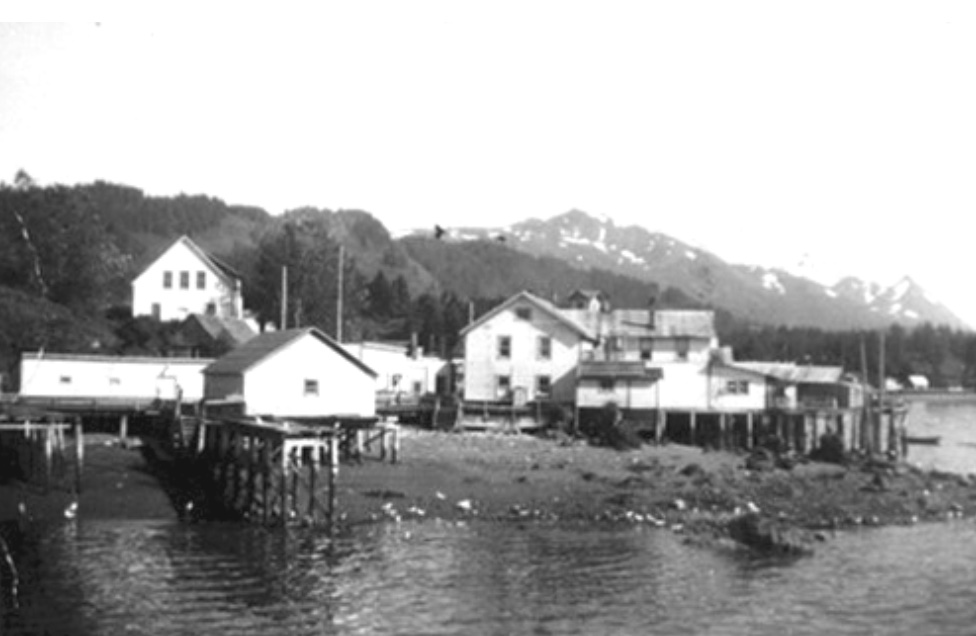
AYR Cannery. On further was the AYR salmon cannery where most of the people on that end of town worked. I was only in this cannery a couple of times and thought that it didn’t look friendly and would rather work for Squeaky.
Morgue. The morgue was just before you got to Young’s store. We peeked into it on the way to school if we knew someone was there that they fished out of the water.
Young’s Store. The walk curved when you got to Young’s store, later Frank Raby’s. It was to us a big department store; it had clothes and drug store items. I think they ran a small banking system in the store, but I’m not too sure of this. They also had a good supply of candy bars.
Swain Family. When I was in my teens, the Swain family moved to town and opened a restaurant across from Young’s store. The girls were Norma and MaryAnn. They didn’t really want to work in the restaurant for their parents, so they hired me. Most of us would rather work the canneries, but I agreed as the pay was good and was steady. I also went to their house, which was by the old graveyard, and washed clothes for them. They had a wringer washer and had to line dry. Mrs. Swain asked me to teach them how to use the washer so I didn’t have to do it too long; besides it was spooky by the graveyard with no one nearby.
Almost connecting to Young’s was Charlie Sharp’s store (no relation to my husband’s Sharps so far as we know). Charlie Sharp’s store was like an old Western store in many ways.
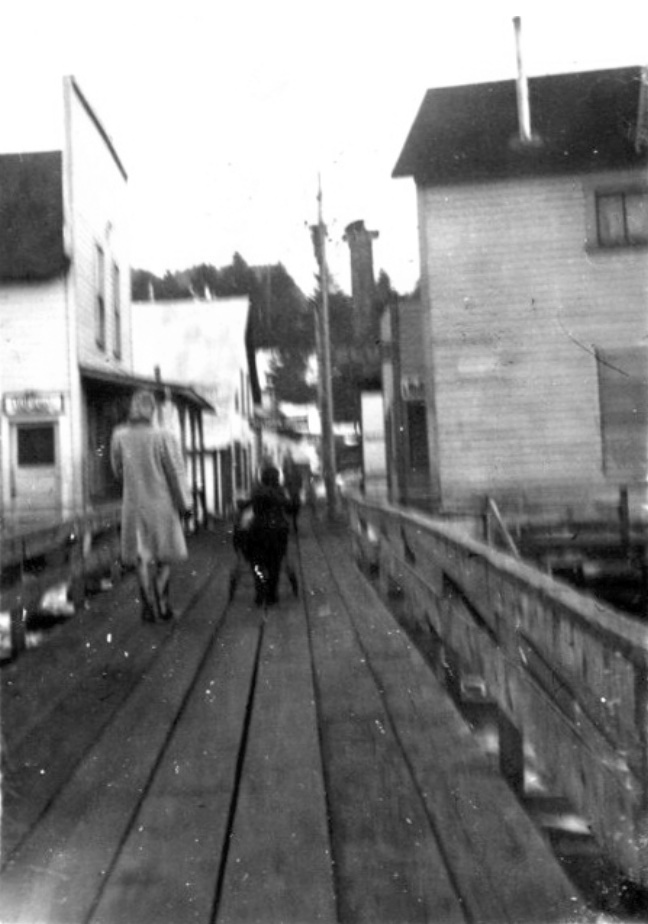
Charlie Sharp’s Store. In the middle was a potbelly stove which was always going, and in front of it was a round table where I saw many old timers playing cards, smoking cigarettes, and telling tall tales. I know that the young boys in town, like George Yuth and Tony Anderson and my brother, enjoyed these tall tales and learned many a lesson from them. The store had counters along both sides and you had to stand on one side and point and tell the clerk what you wanted, not like the stores of today where you fill your own baskets.
We of course had no cars, so carried the groceries home by wagon or by hand. They sold groceries and fresh meat and vegetables when the boats came in, but otherwise mostly canned and dried foods. Charlie carried a lot of tools, ropes, and fishing supplies.
A lot of people like us charged groceries and supplies for their boats that they needed, as the fishermen usually got paid at the end of the season and other workers once a month. I’m sure that a lot of the stores never got paid by some of the people, but they survived.
Frank Raby later bought Charlie Sharp’s store and combined it with his own.
Baltizar’s Store. Down the street was Baltizar’s store. In his store he had a barber shop where he cut hair. I remember Charlie Nelson getting a Mohawk hair cut, which upset all of us girls.
We also bought our ice cream cones there on the way to school, after finding change under the boardwalk.
I played with Baltizar’s daughter in the upstairs apartment, but only remember the small piano that she had that I loved to play. She seemed to be only there for a short time. I also got bit by their small dog, but it was my fault. He was eating a big bone on the boardwalk; when I kicked the bone, he bit me on the leg.
Across the street from Baltizar’s was another bar. I think it was called the Serf.
Colburg Bakery. The Colburg family had a bakery nearby. I remember the big loaves of bread that smelled so good when you went by. Their children were Selma, John, and Calvin. They lived in a big house up a small walk from the bakery. The Ursins also lived on this walk—Radar, Laura, Norman, and Eleanor.
Seldovia House. Next was the hotel, the Seldovia House. It was run by T. W. Lloyd. Later their daughter, Grace Nordenson, ran it. Across from the hotel was the Lynwood Restaurant and Bar, also owned by Grace and her family. My mother cooked in the restaurant and my sister Deloris and I also worked there.
I enjoyed working in the restaurant, but we always had trouble with cockroaches. Once I fried one on a T-bone steak. As I carried it to the customer and was just ready to set it down I noticed the roach sitting on top of the steak. I didn’t even hesitate; I just took it to the hole under the sink that went to the beach and slid the steak right off into the water. The fish probably thought that it was a great meal. The customer couldn’t understand why I did it, but I’m not even sure that I told him that there was a big roach upside down on his steak. We did de-roach the place after that.
Dance Hall and Bar. Connected to the restaurant was the dance hall and a bar. The dances were usually for everyone; people could bring their children, no matter how small, to the dance. Sometimes they would have a special dance and we would have to go to someone’s house to dance, and it was usually ours.
The bar was more restricted; children couldn’t go in even though it had an open door to the dance floor. The only time that I went in was to pick up Erik when I was to take care of him.
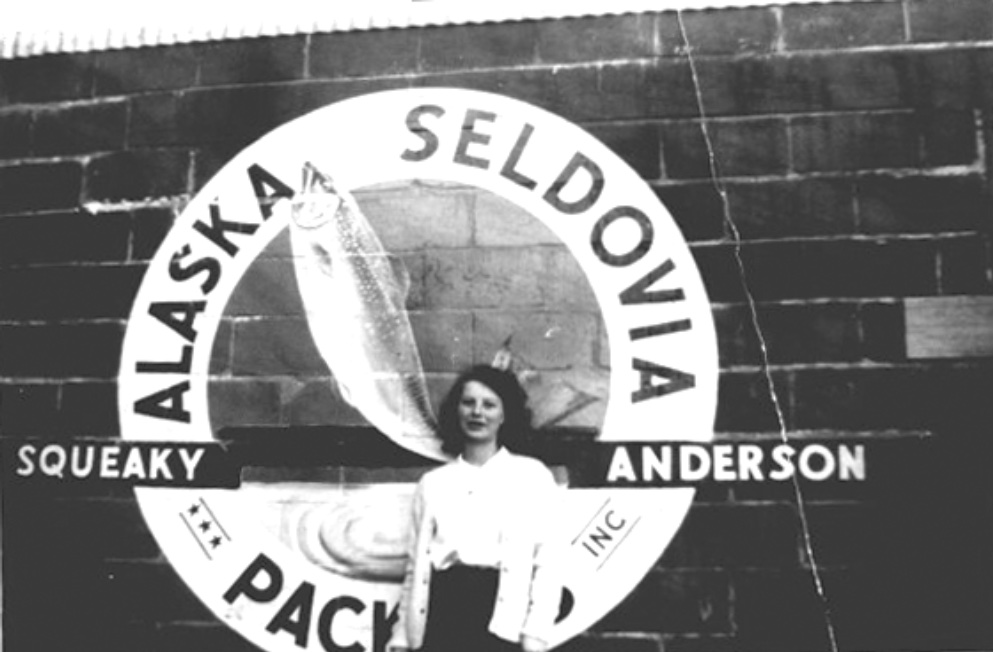
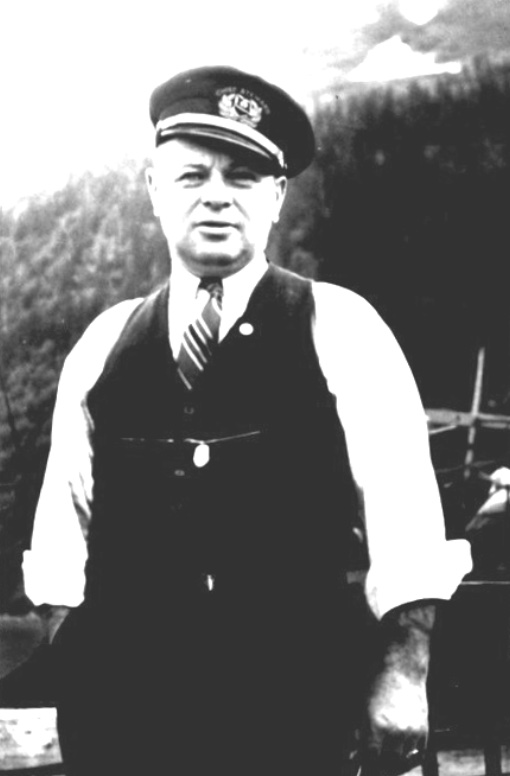
Squeaky Anderson’s Cannery. Squeaky Anderson’s cannery was in the middle of town. It was the Alaska Seldovia Packers. I worked in this cannery for quite some time and loved it. I started working when I was fourteen. When the law came out saying that you had to be sixteen to work, I had to lie about my age, and had to make myself older yet, so my sister Deloris could work before she was sixteen. I’m quite sure Squeaky knew my age because he knew my family. I always tried to hide when he came through the cannery as he would say, “Mae Annette, are you sure you are sixteen?” Of course I’d say yes. I never thought much about this until I went for my Social Security, and they said that I was born in 1929, not 1931.) I heard that Squeaky was in the military in his younger years and was quite a hero. Most of the kids from the slough end of town worked for him.
I worked mainly as a patcher and filler person, but was taught all the jobs by the Philippine workers. I slimed fish, worked on the Iron Chink, made boxes, and did anything to make more money. We had no freezers in those years, so when the fish came in we would work until it was done. Once I worked on the filler with Norma Swain for three days and nights; it was hard trying to keep each other awake.
The canneries then had grocery stores, and most of the things people wanted were sent for and brought up on cannery boats. There were many cannery tenders for the three main canneries. I have been on a few of them as the people of Seldovia took care of them through the winter and they would let the kids go on board the boats.
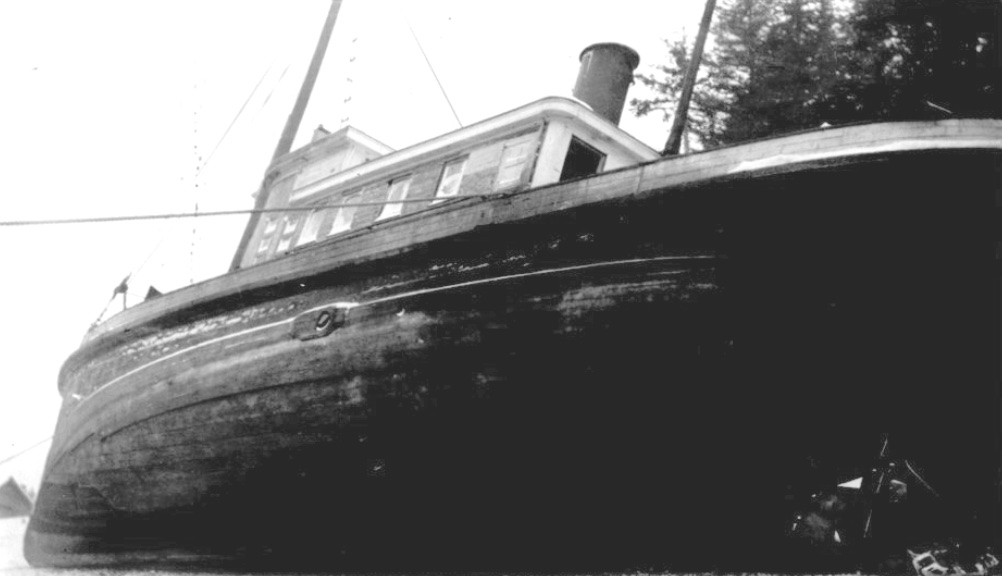
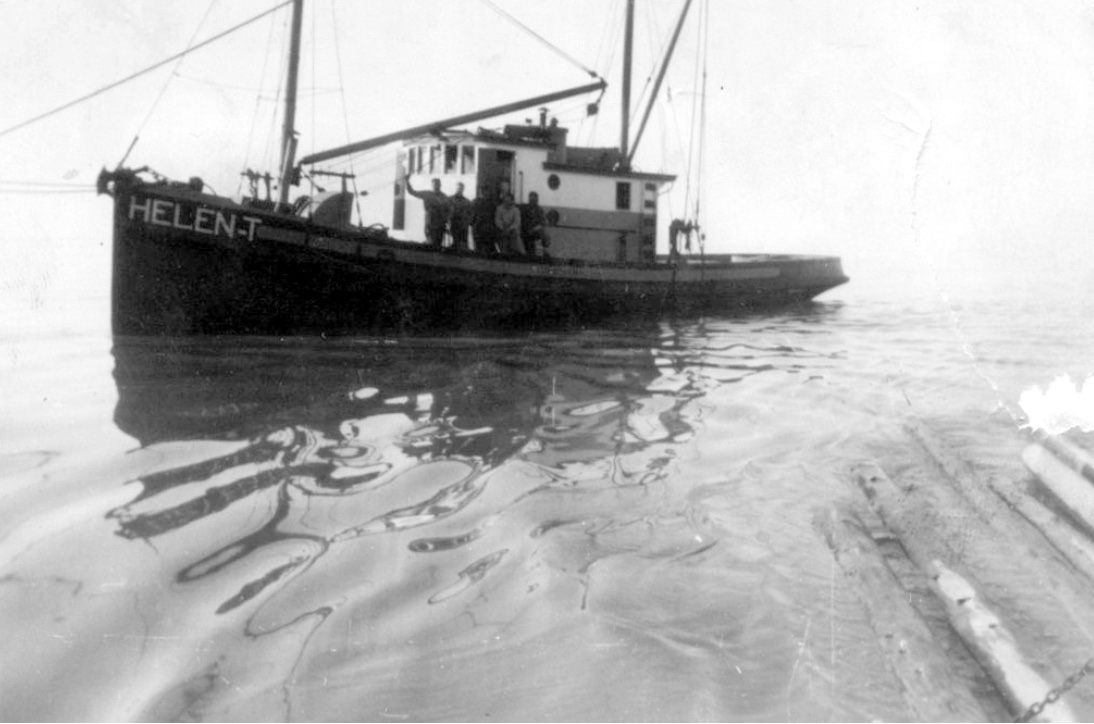
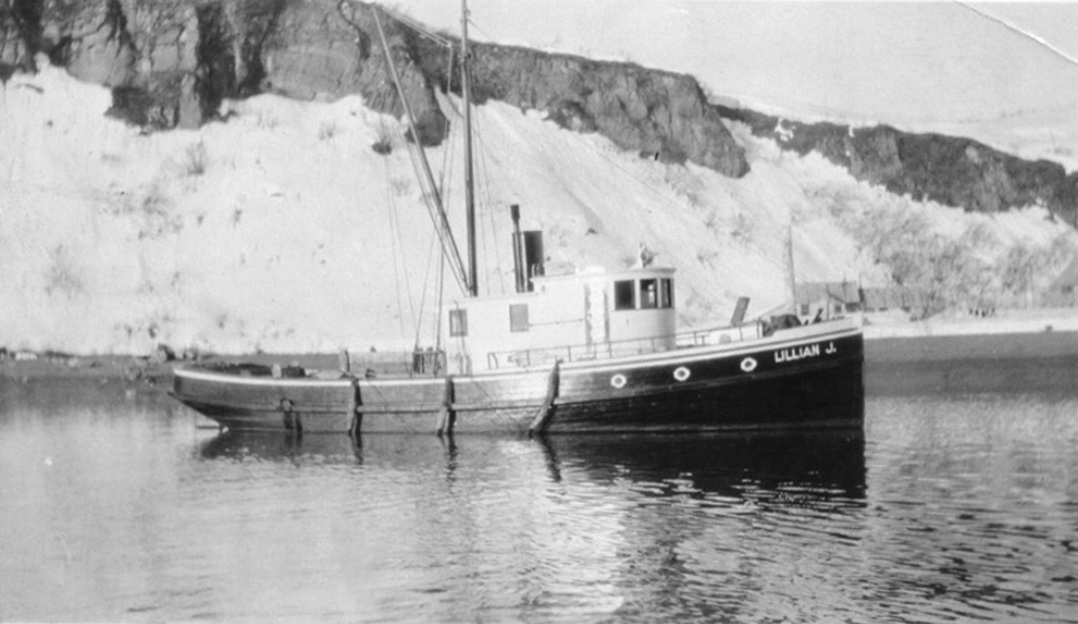
Library. The library was across from the cannery. It was a large red building and at one time had a school in it which my mother went to. It was called the American school, as they also had the Russian school down the boardwalk next to Rush-on Cafe, which was a log building. My mother first went to the Russian school. The library had city offices in it at one time. All of our 4th of July celebrations were in front of the library as this was the most space in the center of town.
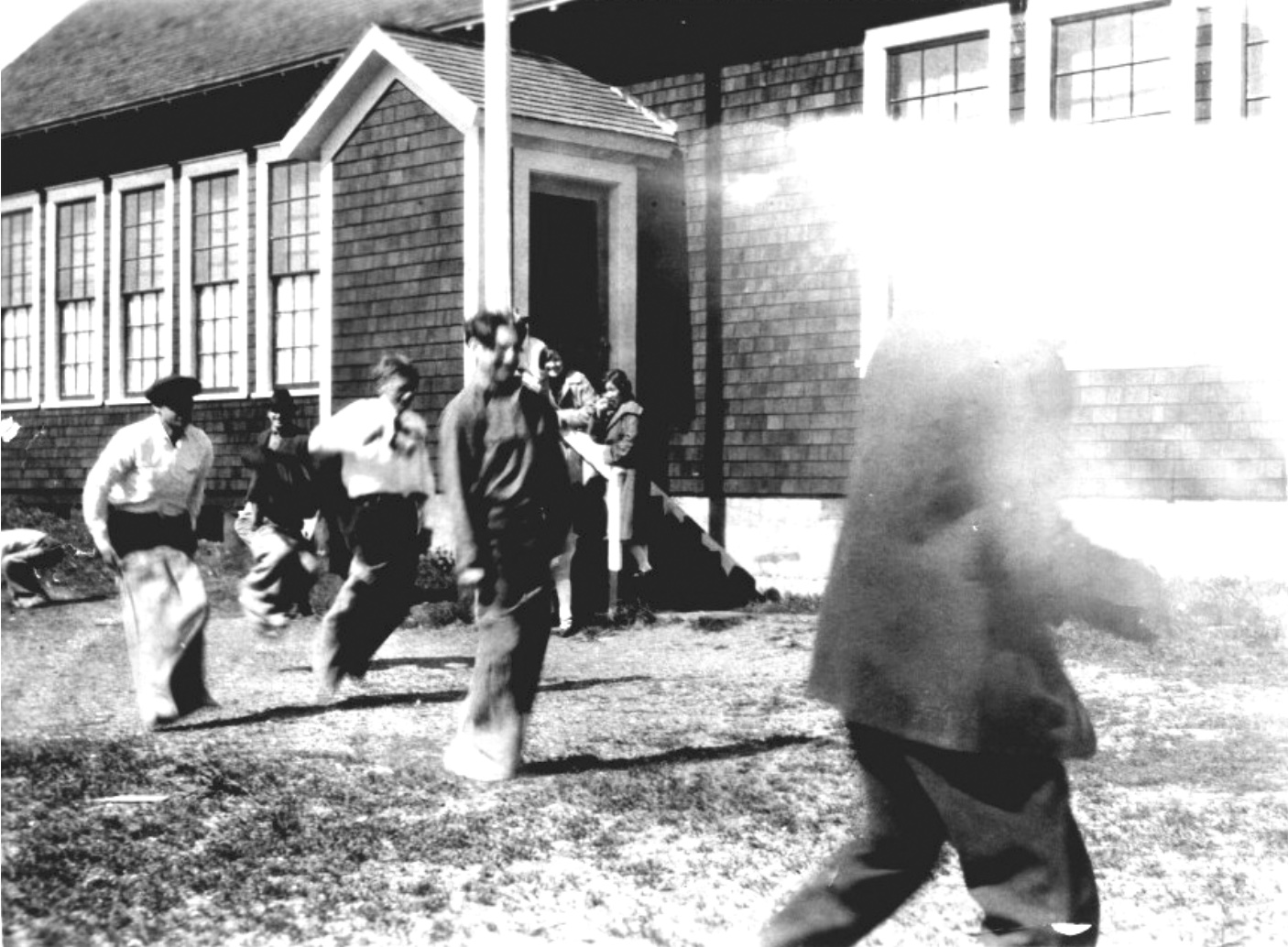
4th of July. The 4th of July brought out everyone in town. There were parades, races of all kinds, pie-eating contests, and of course fire crackers. We never had the big fire works that they have today. The adults had their races just like the children. After all the activities, which took all day, we always had a big dance.
Shipwrecked. Around the 4th of July we always wanted a boat ride. If the water was rough all the better. We would get the boys to go as far as they could into the bay without us swamping. It was a thrill to have the water wash over the boat.
One day we couldn’t find the boys with their boats to take us, so everyone scouted around until they found someone. It was about twelve or so when we found a couple of guys to take us. Someone found them coming from the bar. At the time we had no idea that they were drunk and they probably had drinks in the boat, too. We took off on the boat, probably about a 34-foot boat. We headed up the head of the bay. The bay was calm and the tide was going out when we hit a sand bar and the boat stopped. It was a round bottomed boat, so the two guys went out with two long planks and propped the boat up so it wouldn’t lay over on its side. Seems like they were used to doing this. They went in the bunks and went to sleep.
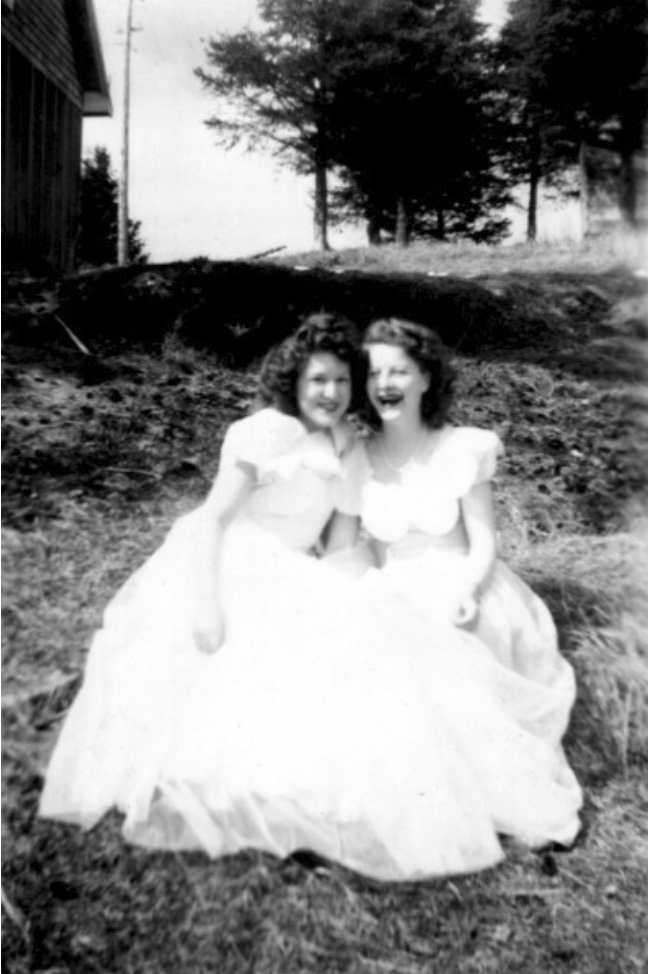
We sat outside and sang and played pirate and shipwreck, even climbing the masts. We weren’t concerned as it was daylight all night. Helen Yuth and I cooked corned beef hash for all the kids. This was the only thing that we could find on board.
About midnight we heard a small boat, which was the Majestic. I think the Majestic was the smallest boat in Seldovia. We found out that they were coming to rescue us. When we came into town it was midnight. We landed near the post office. On the beach was the whole town. They thought that we had all drowned and they were all crying. We got bawled out for doing this, but this was fairly common so it wasn’t too big a deal. Besides, when the tide went out completely we could have walked to town, but it would have scared the families even more if they had gotten to the boat and couldn’t find us.
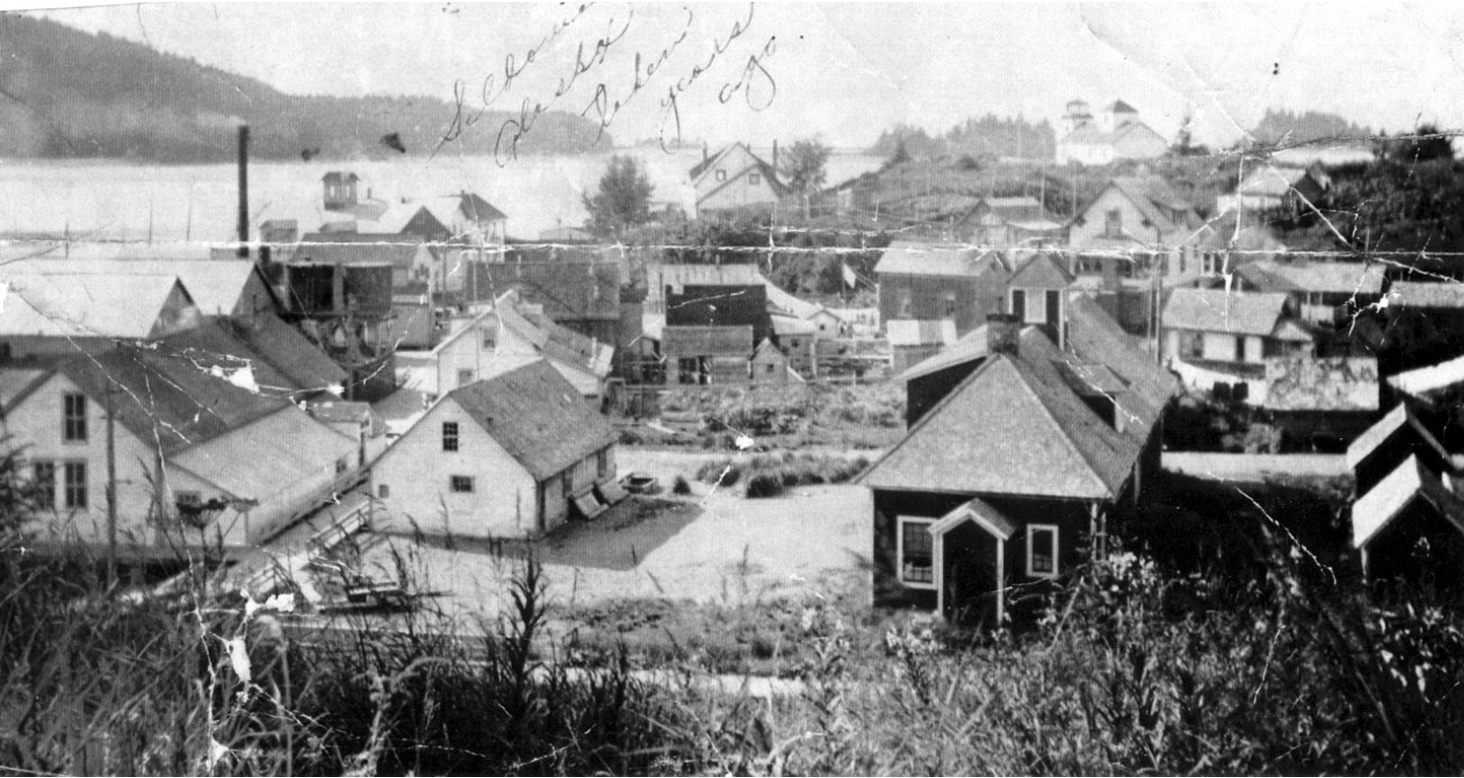
Lipkey. Still following the boardwalk, we came to Adam Lipkey’s. He had a radio station there. Mrs. Lipkey also had a store when I was in my teens and I bought dresses there. I think that she ran the library; I read everything in the whole library especially the mystery books. The book I hated the most was Water Babies. I picked it for a report one time because it was such a big book, but I couldn’t understand any of it. I ended up copying the flap for my report and of course the teacher found out and I was in trouble. I haven’t read it yet, but plan to some day.
In the 30 January 1930 Seldovia newspaper, it said, “Mrs. Lipke’s musical compositions stir Seattle audiences. The great pipe organ in the million dollar New Orpheum at a recent Sunday opening rendered four of Mrs. Lipke’s creations.”
We had other talent in town. Mr. R. C. Morris played a cornet and they did have an orchestra which played at the dances in Hill’s Hall. We always had the “jute box” for our dances, and it was fixed so that we never had to put money in it.
Rush-on. Next came Russian John’s restaurant. He was a big friendly man who made the best doughnuts. As far back as I can remember, my mother worked for him as cook and waitress. Mary Jensen also worked for him. I used to help my mother clean up the restaurant after closing. Russian John would make me pull a doughnut and drink a big glass of milk whenever I came in. I never got a whole doughnut.
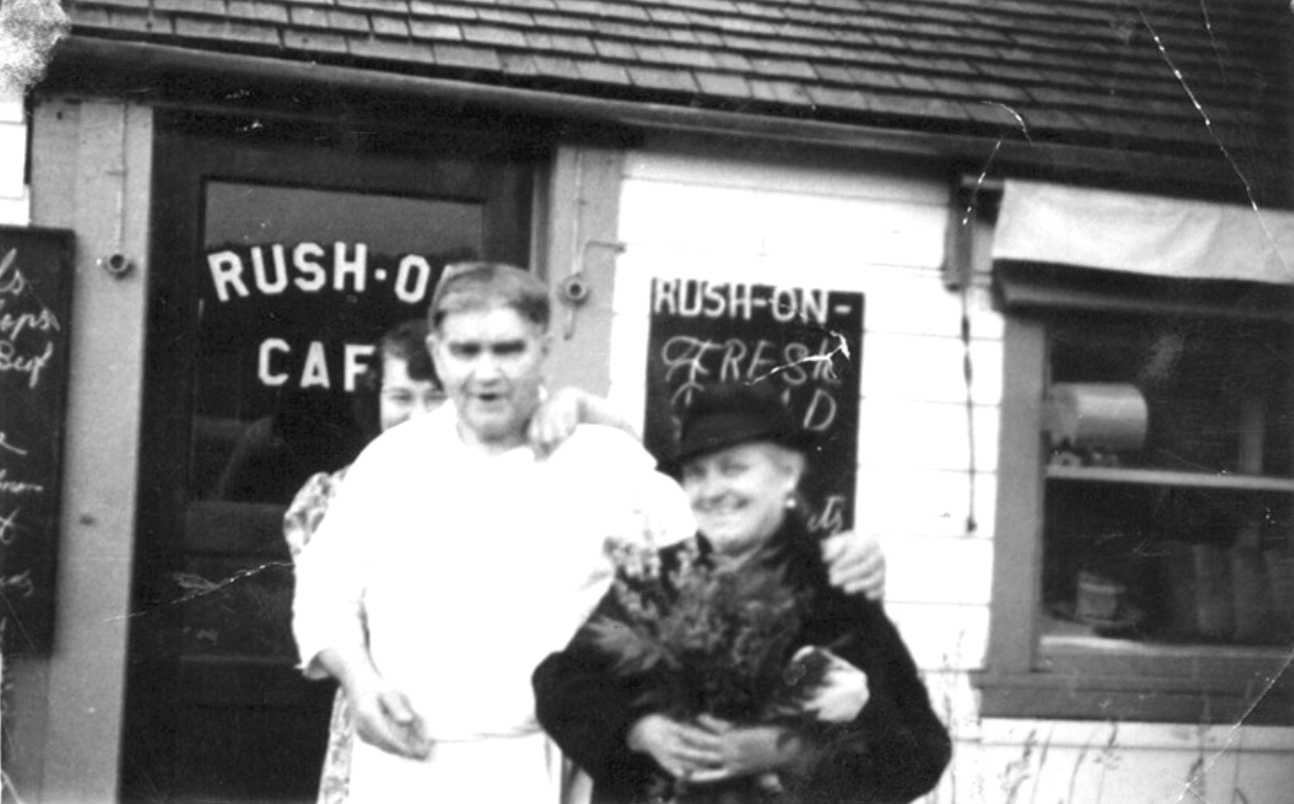
Russian John would always tease me when I went in. He would say, “Mae Annette, when you turn sixteen, you and I are going to the Fiji Islands.” I would say, “No, I don’t think so; that’s too far away.” He would also say, “When I die, your mother will be rich.” It didn’t work out that way, which was usual in the small Alaskan towns.
Estas’s Cannery. Estas’s cannery was next. The workers were from other places such as Hawaii. The Estas’s had a couple of children, one of them Caroline. She and I would run through the cannery, climbing on top the boxes of cans, playing hide-and-seek.
Haunted House. Up from the cannery on the water side was the haunted house. When we would go by it at night, we would peek in the window if we were brave and not alone, scream and run like crazy. I don’t remember who lived in it; it was always empty, except once when two women thought it was a good place to run a business, but they were run out of town. Before I was born, a relative of mine lived in it.
Bill. Bill had a machine shop and had only one leg, so had a peg leg. Once Helen Yuth and I had just come from a spooky show about a peg leg man. We were near the haunted house by Shortley’s corner when Bill came walking behind us. It was really dark. When we heard his thump-thump from his wooden leg, we looked at each other and screamed and ran home like mad. We felt so bad afterwards and stupid, too.

Cap’s Hill. On the other side of the haunted house was Cap’s Hill. It was Captain Fillmore’s property. We always thought that it was named after Captain Anderson (Squeaky). In the early years Captain Fillmore grew potatoes on this hill to make whiskey for the town, I was told. Everyone had big gardens and furnished the families with vegetables.
Cap’s Hill was such a neat hill; we would climb the rocks near the water for wild flowers. When we weren’t working, some of us girls would sit on the bank above the cannery and watch the boats come in and embroider tablecloths and pillow slips while we talked, keeping an eye out for people on the boardwalk below who were coming and going.
Superstitious. My great aunts were Russian Aleut. Maybe it was the the Aleut or the Russian in them that made them so superstitious, and they passed it down to the families.
My great aunt Barbara was the most superstitious, and she could always tell when someone was going to die. She would always say that they came in threes. If anyone drowned, none of us were allowed to go in a boat or near the water until the third person drowned. If a bird hit the window of a boat, the fisherman could expect a drowning.
My grandmother had a fur coat and she told my mother that it was hers when she died. She didn’t want Sue, the older daughter, to have it. Mom said that after her mother died, every morning when she woke up the coat was on her bed. She would hang it in the closet and the next morning again it would be on her bed. They finally had to burn the coat. To this day if a bird hits my window, it scares me. I don’t want to walk under ladders and if a cat, black or white, crosses in front of me, I turn around because I don’t remember which one was supposed to be bad luck.
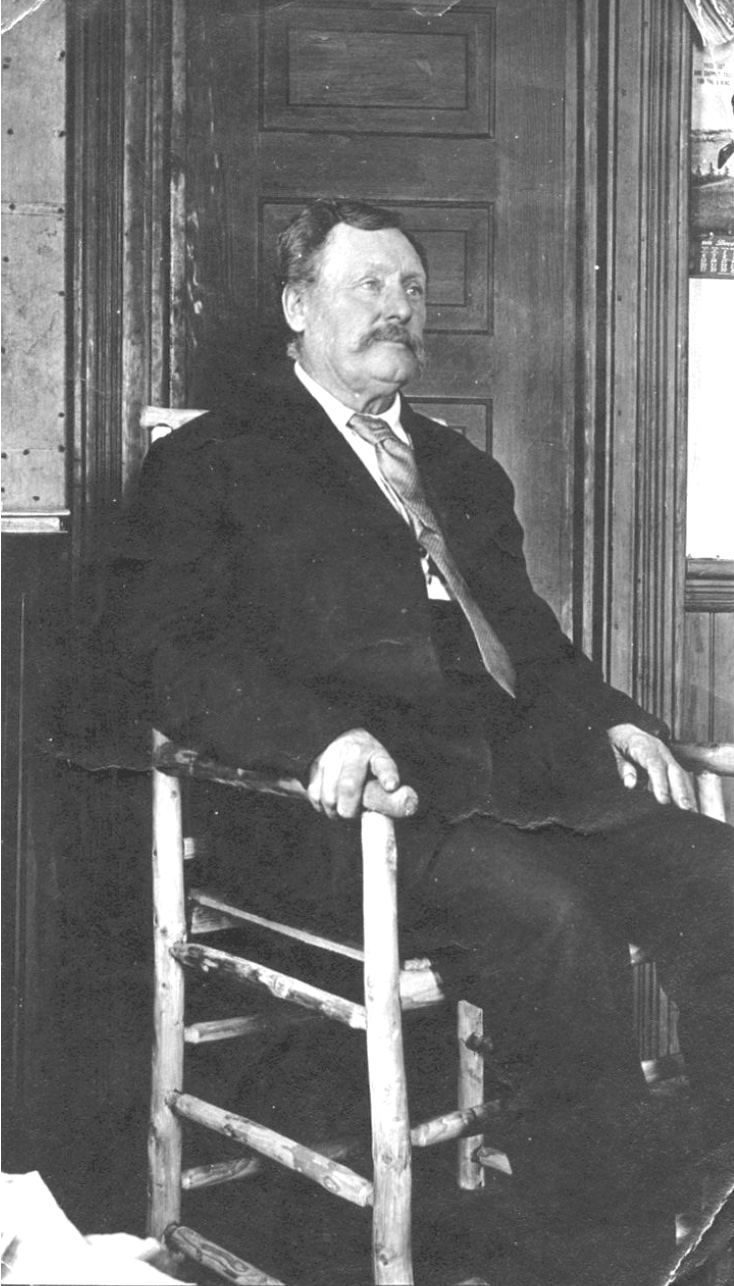
Shortley Hotel. The boardwalk went around the corner of the cliffs and there sat the Shortley Hotel. I was named after Shortley’s wife, Annette. There was also a meat market at the end of the hotel. I think the name of it was McDonald’s Meat Market. Mr. Shortley would send me home with ham or meat now and then for the family. His wife and my grandmother were great friends. Another owner ran the hotel but I don’t remember who. Later on someone had a small ice cream parlor nearby.
The Vinburgs lived just off the boardwalk, with a long narrow walk from the main walk to their house. Jennett, Mae, Alice, and Ivy lived there.
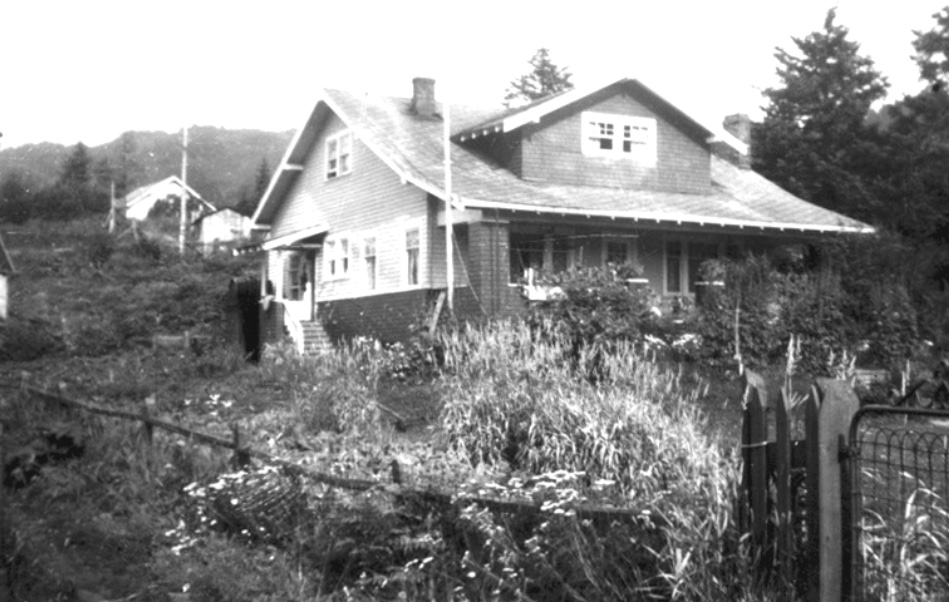
Movie Theater. Down the boardwalk from there was, in later times, the movie theater. I worked in it for a while selling tickets and orange crush, and being an usher. Tickets were only 25 cents, but I think the only movies I saw were western and Charlie Chan. Before the theater we had movies at Joe Hill’s and the Linwood dance hall.
Polar Bar. Next was the Polar Bar, which Joe Hill had after his big place burned. In it was a barber shop where he cut hair and also sold candy bars, so we got to go in it now and then.
John Roe’s. My aunt Florence and her husband Charlie lived in the big house that was behind the Polar Bar; we knew it as John Roe’s. She ran a boarding house from it. Aunt Florence later lived between the library and the Russian school, then down to the end of the cemetery in the big white house.
Morris’s Store. Morris’s store came next. His store had everything, from shoes to groceries to horehound candies. I don’t remember him selling meat or fresh fruit or vegetables though. He had barrels of crackers and one barrel had jersey crackers but I have never found them since then.
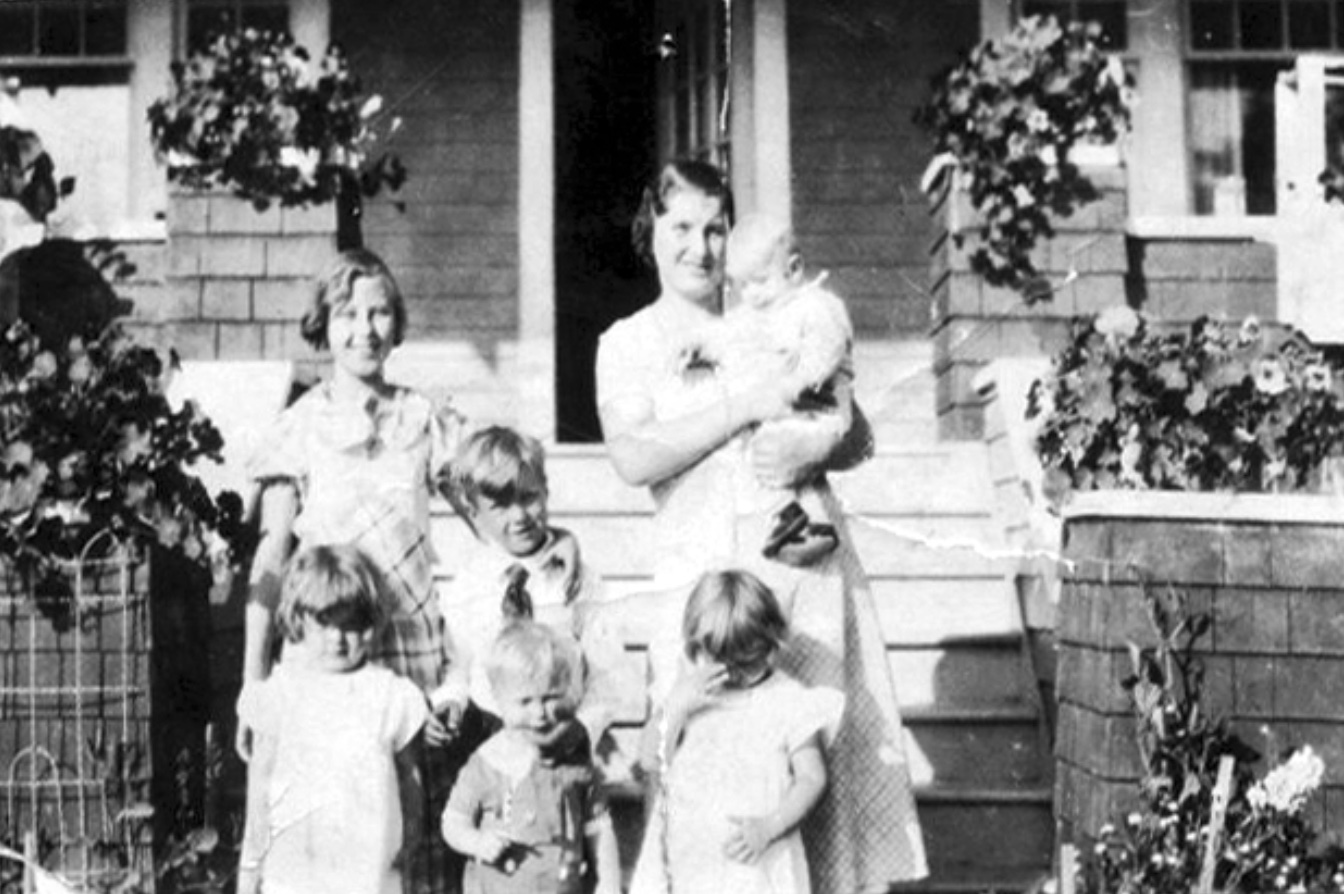
Mr. Morris was English and he and his wife had two children, Dick and Lynette, and a dog. They were older than I, but I still played house with Lynette in an old green house at the back of their store. They had a huge white house and all our family pictures were taken by them in their front yard. People thought that it was our house when they saw all our pictures.
Fred Bowen. Down the walk a little further you crossed the dirt road that was a shortcut up the slough. When you stay on the boardwalk, you first came to my uncle Fred’s house. Fred Bowen was my grandmother’s brother and was only about four years old when his father Captain Henry R. Bowen drowned at sea near Kodiak on the boat the Seventy Six in December of 1895.
The house was built by my great grandmother’s husband Bill Rhodes. He also built the house alongside of it. She lived in the first one and her husband Bill lived in the second one. When she married Bill after her husband Henry Bowen drowned at sea, she was married by a captain of a ship. She was a very religious woman and didn’t feel that this was right, so she went to San Francisco and remarried in the church. She still didn’t feel right about it, maybe because she had so many children in Seldovia by Henry Bowen that she couldn’t accept the marriage to Bill Rhodes.
When Uncle Fred’s wife Annie died, he was left with a large family. He sent the younger ones to the Seward orphanage and he raised the older boys.
Grandma Meehan. Grandma Meehan (not my grandmother, but we called her that) lived in a big house over the water on the other side of Uncle Fred’s. She painted beautiful pictures of scenery and flowers on oval slabs of wood. I would go visit her with her granddaughter Pauline. I once broke my double string of pearls over her back patio, which we called a dock. They disappeared in the water and sand.
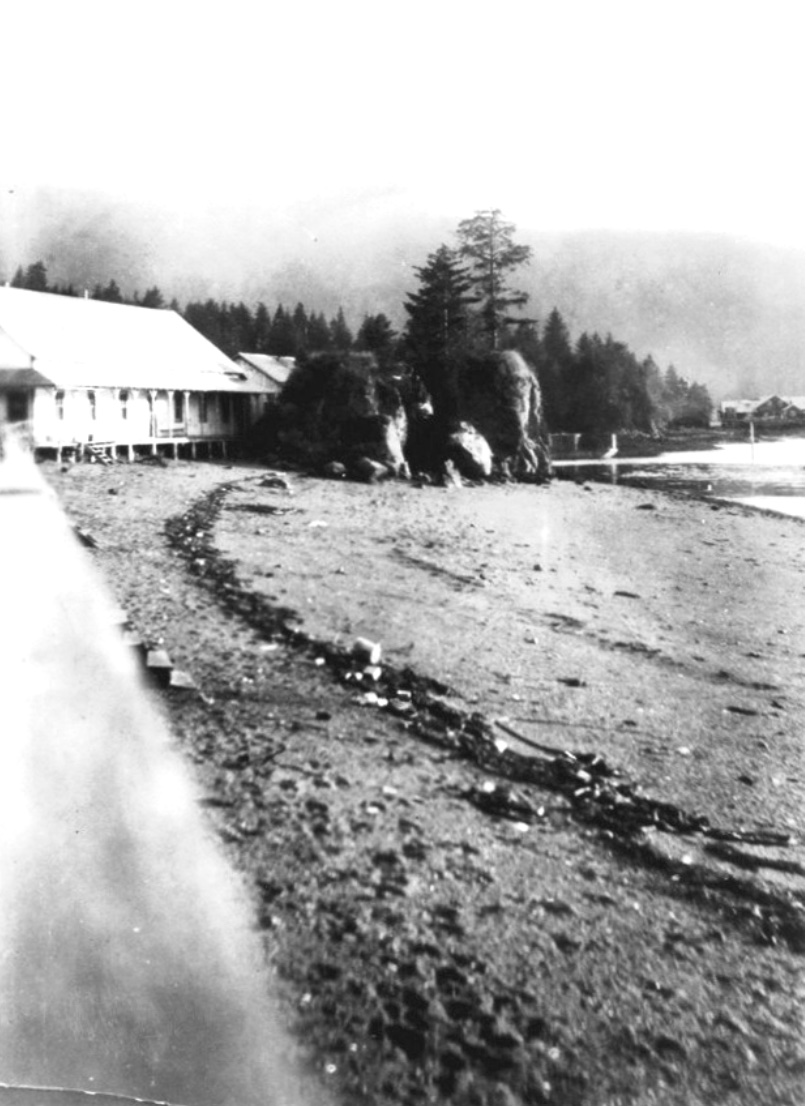
Joe Hill’s Hall. At the point or end of the main boardwalk was Joe Hill’s Hall, which had a barber ship, theater, and bar. It was a sad day when it burned to the ground; I think all of Seldovia cried. For months we dug bottles of pop from the sawdust that was under the building. The sawdust was there to keep the ice frozen. He would get big blocks of ice from the lake to keep the pop and beer cold. At that time even Joe Hill didn’t have a refrigerator.
Alice Nutbeem. From this end of town the boardwalk went up hill along the slough. It went past Alice Nutbeem’s. Alice was a neat lady. I liked to visit her and have tea. Whenever you visited the older people, they always had tea and smoked salmon or a treat. She liked to walk and visit everyone.
When I went back years later after the earthquake, I went walking with her. She knew my dad’s family from Unga, but wished I knew them enough to talk with her more about them.
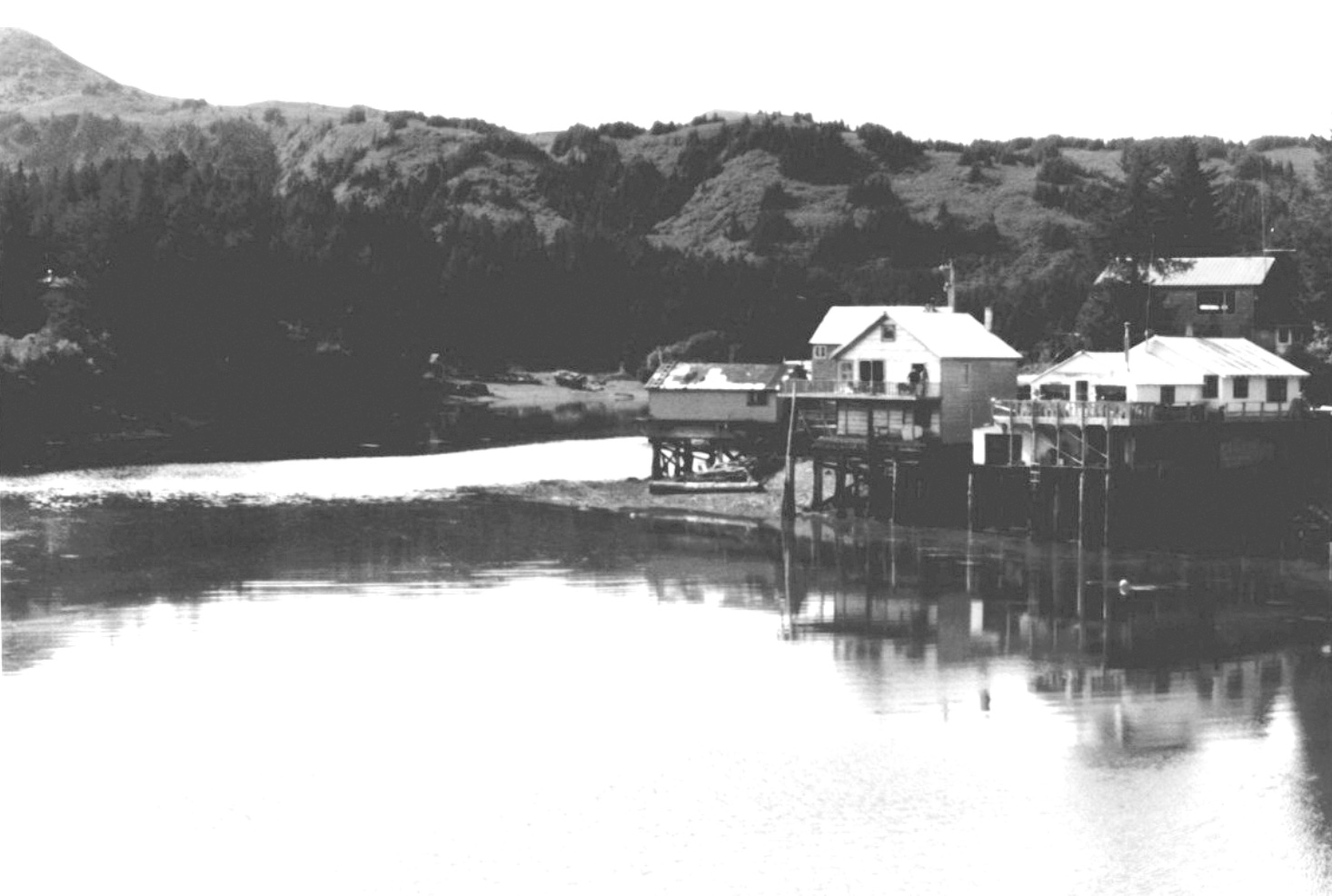
Hogenson. The two Hogenson boys, Nick and Harry, lived with their father up this walk. One of the boys had a hair lip. Early in the morning when you walked by their cabin, you would see them sitting together on their steps whistling. They always seemed to be happy.
Hennington. Another big house, on the hill up further, was the Henningtons’ house, and one of my best friends, Alta (Patty) Rosenbush. Hennington was Pat’s stepfather. Her sisters, Anita, Betsy, and Barbara, all went to school and played with us. The walk ended there and went on to a dirt road.


Mr. Martin. Mr. Martin lived in a big house near theirs and his son Raymond went to school with us. Once my sister Deloris was stuck in the mud below his house and he just stood on his porch and watched her. She almost went under in the quick mud, which was like quick sand. She had a hard time getting out as she had big boots on.
Lund and Crawford. Going back to the road between Morrises and Uncle Fred’s house, was a hill. At the top of that hill was another bachelor who had the well with my grandfather on his property. Later I believe the Lunds lived in the house. At the end before the road turned were the Crawfords, John and Helen, who were close to our ages. They had a neat house where they could fish off their dock.
Beach Family. The Beaches’ house was next, and my mother bought it after I left home. They had a large family and lived up near the sawdust pile before that. Alice and Helen were the girls and they had several boys. Shorty Beach was a beautiful boat builder and built many of the Seldovia boats. I once asked Shorty to be my dad. He laughed and figured one more wouldn’t make any difference as he had about eight. One boat that he built was the Alice.
A few other homes on the waterfront were lived in by bachelors.
Mary Jensen. Mary Jensen had the tiniest house. It was like a doll house. Mary was a nice woman who took care of us a lot when my mother worked. We always visited her, eating goodies out of her great garden. I would get talked into going under her house which was just a crawl space and stirring her sauerkraut, which was in several barrels. We knew she drank, but never remembered her drinking in front of us. She was always there if we needed someone.
Kavorness. Kavornesses lived next to her in a long white house; Edwina and Lola were the children. They left Seldovia when they were still young.

The Bridge. Across from the Kavorness’s house was the bridge that went across the slough. It had a place where you took a couple of boards out if a boat was coming by. You took out a board and you climbed in the space and pushed down with your feet. The middle of the bridge came up to let the boats go through. I tried this once and it nearly scared me to death. While I was pushing down I was afraid that it wouldn’t stop and I’d end up in the water. My feet kept going down and I had to keep hanging on with my fingernails; I thought I would split in two. Daring me, I had to try everything. That was the only time I did that.
When the tide came in or started to go out, we would all race to the bridge to watch the salmon coming up stream, and then going back out to the bay. We used treble hooks and snagged the fish as they came by. It was a long hard struggle to pull those big dog or chum salmon up to the top of the bridge. I don’t think any of us weighed a hundred pounds.
The Farm. The bridge led to the farm where we got fresh milk now and then. It went past the Waterberrys’ house, and on up to Erickson’s cabin in the woods. Erickson had a bonya and when he wasn’t home we were allowed to go to his place and build up a fire and have bonyas. The bonya was a small building separate from the house. Inside was a rock fireplace. On top of the roof was a big drum that you filled with water. When the fire was hot, we would pour water on the rocks to make steam and would wash with soap in a basin of warm water then pour the cold water from the roof drum on us. We would also in the winter go out barefoot in the snow after a bonya and it never hurt us.
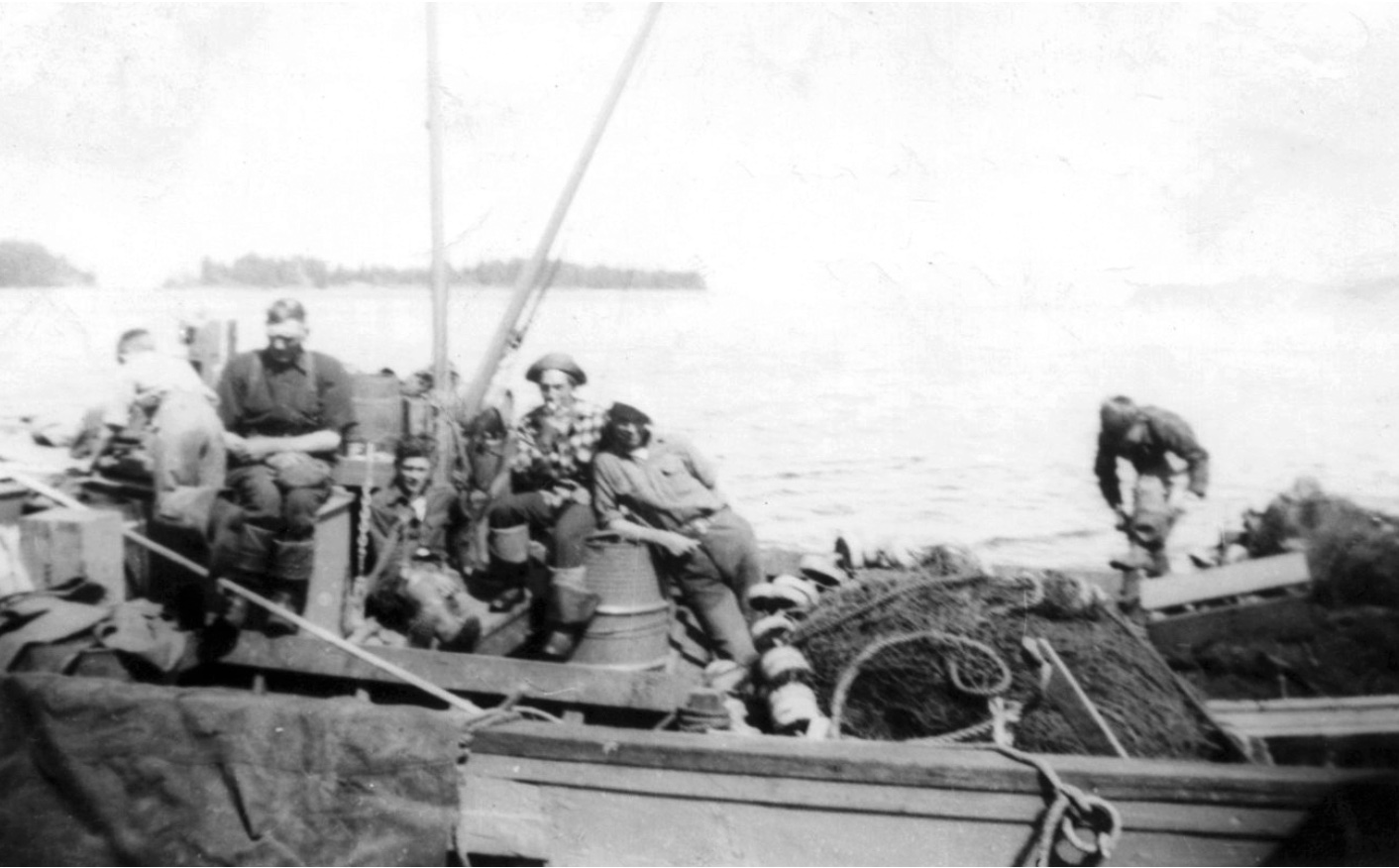
Fish Creek. Fish Creek was up from their cabin where we caught the little trout with hooks that were usually hidden in the tree nearby. We always made sure if we were going to fish to wear a red sweater so we could use the yarn from our sweaters as bait. We would catch the small fish and string them on a small branch, then roast them on a campfire. We never bothered to clean them as they were so small and the meat just peeled off the bones and guts when the fish were done.
A small cabin was on the way to the creek, and some friends of ours rented it for a while and we would go up there at night and sit around in the dark telling spooky stories. Was scary walking home. There was also a small pond that we skated on a few times, until I went through the ice.
Waterberry Family. Waterberrys’ house branched off the main road before we got back to the bridge. They had a big family; I remember Marian and George. The Josephsons’ big house was above the slough on the other side of the bridge and slough. I went to school with Simon and Lillian but she also had older girls.
Nellie Rudick. Up further on the trail lived Nellie Rudick, a friend of the family. She had a red house on the beach between two hills, and we had to visit her on the way to the old cannery beach. Down the beach further near the point, which was the other side across the bay from the boardwalk, was another house, but we never went there much.
Cannery Beach. When we wanted to row to the Cannery beach, we would row across the bay and, instead of going around the point, if the skiff was small enough, we would push and carry it across the bar to the other side. Sometimes the water would be too rough to go around the point.
On the other side of the bay was an old cannery that was burned down years before. When the cannery was there, you could see it from Seldovia. You could still see the old pilings and find things in the sand that came from the cannery. They used a lot of Chinamen to work there. My brother found an old machete buried in the sand on the beach. It was a great place to find salmon berries, blueberries, and also wild strawberries on the hills, and it was fun to climb the cliffs and pick wild flowers. It’s a wonder I never fell from the cliffs as I climbed all of them. The beach was mostly rocky, but parts of it were nice and sandy for lying in the sun and picnicking.
What fun it was to lie over the bow of the boat and drift along the cliffs when the tide was high. There were always shells, crabs, and bottom fish that darted in and out of the rocks. I think I miss this most about Seldovia.
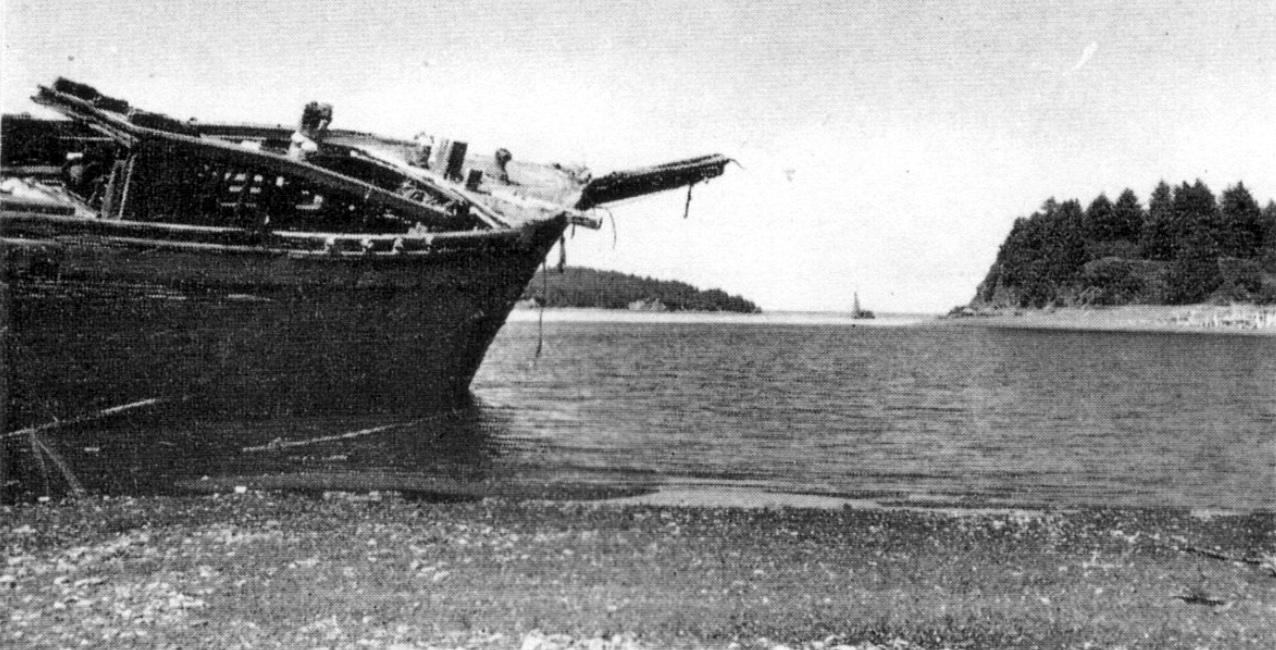
The San Salvador. Up from the old cannery was an old sailing ship, the San Salvador. I believe it was a Libby’s ship, put on the beach by Axel Anderson, and that it was used first to carry lumber, then herring and salmon, to Seattle. We would climb up a rope to get on board and run all over it. We would slide down some chutes to get to the bottom. There were all kinds of things to explore and we would pretend we were sailing on the ship. It was lopsided, so we walked on a slant. One side was always in the water and was a long way down. We had to get off it before high tide. You couldn’t follow the beach further up because of the high water, and we never got off the ship until the tide was high; then we had to or swim, but the water was too cold for that; besides I don’t think any of us swam.
There was a path up over the hills and through the woods where there were several cabins. We always stopped at the abandoned ones and looked for gold that the old-timers were supposed to have buried. We never did find any, even though we dug around all the stumps, but it kept us busy and hoping.
We always heard that there was a pot of gold at the end of a rainbow. When we saw a rainbow, we would look to see where it ended, never looking to see that it moved. Only once I dug when it ended near our house. I never did find gold.
Morris’s Cabin. If you followed the beach up to Seldovia River, you would come to Morris’s summer cabin. My brother Tom said that it was spooky staying there at night, because you could hear what they thought were Indian drums all night long. It probably was water lapping up against the rocks and banks, but it kept the girls from wanting to stay up there.
In the fall the creek was full of salmon, mostly dog (chum). If we had our twenty two with us, we would try and shoot one, but I never shot one, because they were too fast. We would cook it over a campfire if we did. Nothing tastes better than a fish of any kind cooked over a campfire even without pepper and salt.
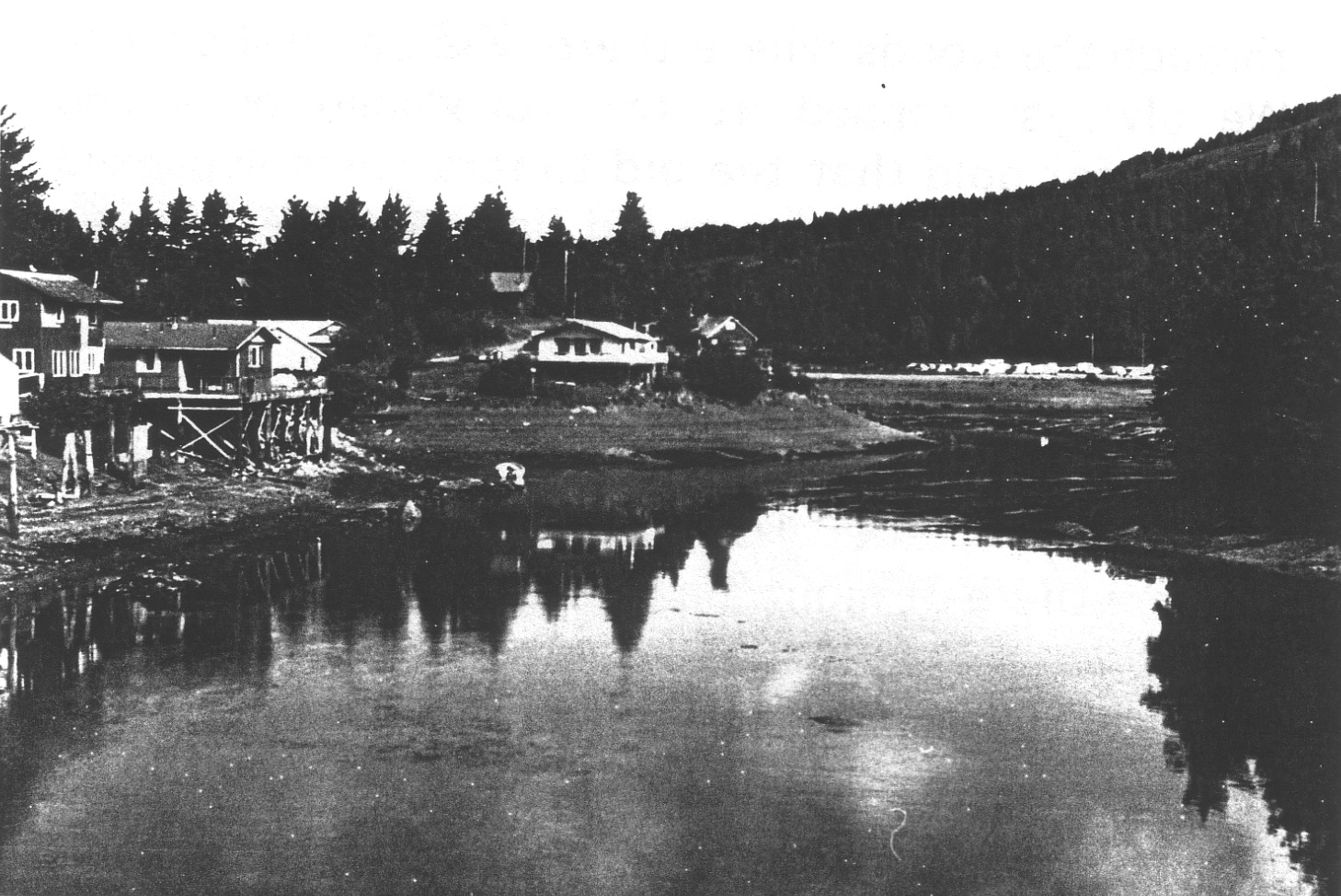
On the way up to the head of the bay you passed a house on an island when the tide was in. When the tide was out, there was a narrow strip of sand that you could walk on all the way to the house. Near this place we would take a skiff and lie on the bow and stern and pew crabs out of the shallow water. There were hundreds of them.
Our White House. Back to the bridge, turning right on the main road (the only road) we passed Kavorness’s and then came to our white house on the hill. The house is gone now and Fred Elvsaas has a home there. It was a big place, a large living room, a bedroom, bathroom, and a large kitchen downstairs. There was a big upstairs and a full basement with a room in it with dirt floors. We used this room to hang our moose when we got them, as there they stayed frozen all winter.
We moved into it when our grandfather was real sick. The day we went to see the house, the Beach children were with us. As we went up the stairs I had a scary feeling, which never left me till I left home at age eighteen. Someone had died in the house we heard, but not till later. I think that the house was haunted and so did all of our friends. When I came home alone even as a teen, I would never go beyond the living room.
When my father died in Seattle, my mother saw a ball of fire roll up the curtains. Two of her friends thought that a hand came out of the sewing machine drawer when they looked in the window to see if anyone was home. The night before our grandpa died, my mother had a glass coffee pot in her hand and it just shattered; she felt that this was a sign of disaster. When Papa (grandpa) was dying, Mom went to his house just over the hill, as he was not expected to live. I heard steps on the basement stairs. In the kitchen we had a spring door near the stove. A knee (gray-white) pushed the door in. I had a machete which my brother found at the old cannery beach, and was hollering, “Don’t you dare come in.” I gave Deloris a butcher knife and called my brother Andrew downstairs and gave him the machete. I then ran up to the top of the hill and screamed for my mother who came right away. She checked and there was no one there. No one could have gotten in the basement from the bottom as the door was barred and the windows couldn’t be opened. There was no way anyone could have gotten in, but to this day I know something was there on the stairs.
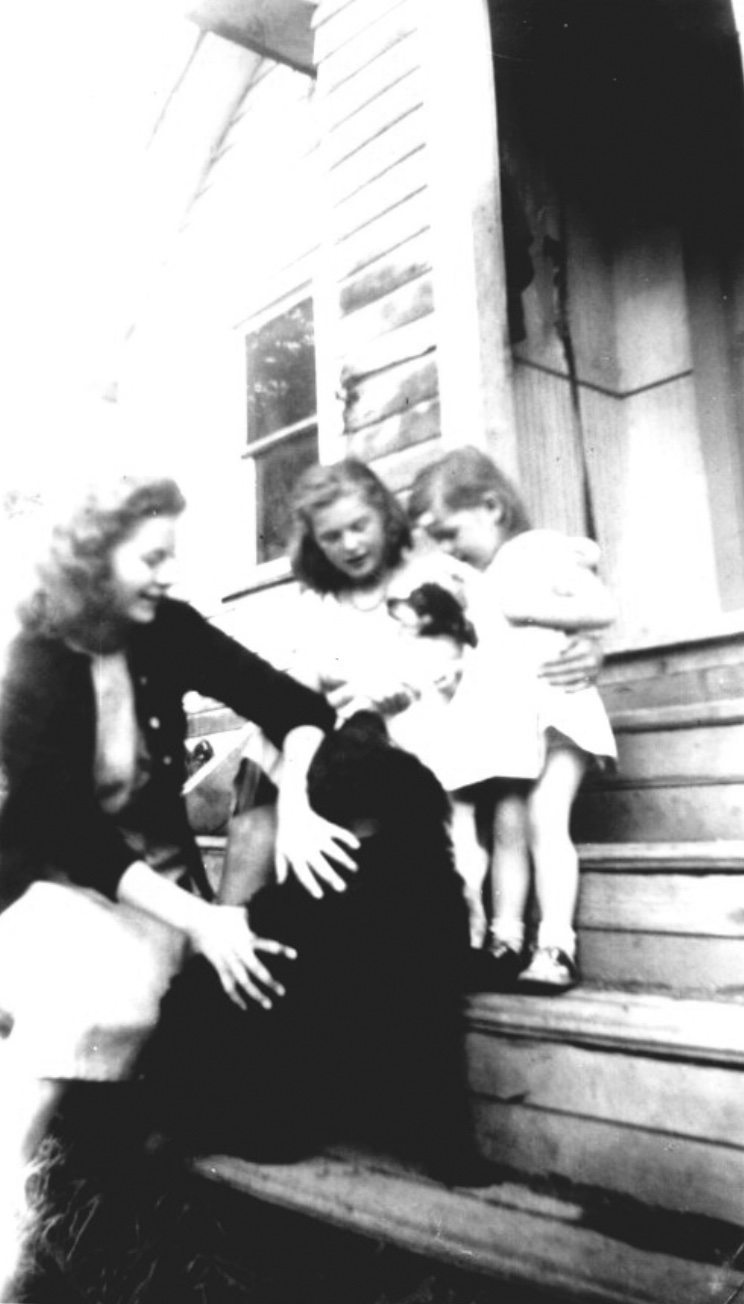
When we first moved in, we had no running water or bathroom. Saturday was wash day. We had loads of washing and we had a wringer washer and in the early years had to carry our water from Jack Wormenson’s well at the other side of the hill behind our house, and then had to heat it on our wood stove. Deloris and I did the wash; she would clean the living room and I would clean the kitchen. When I cooked, she washed dishes. I remember Mom using a copper boiler with a plunger to get the dirt out of the boys’ pants.
Water. When we lived in the log house before we got running water to the house, we also carried water. I remember a yokelike thing made out of wood that went around the neck and had a hook for a bucket of water on each end. The well was dug by my dad and others. I can remember when they dug the well they had a deep hole and made a crib of wood with two by fours; as they dug deeper, they kept adding more slats to the crib. To get the water, we had to drop a bucket down on a rope and pull it up, then dump it into our buckets.
We would have to bathe in a big wash tub by the kitchen stove. I think I was first to use the water as several of us used the same water.
We had an outdoor toilet that was always knocked over on Halloween, probably by my brothers and their friends. Later we had a 100-gallon drum cut in half as a bath tub and then a real tub. Then we had city water, which was great. All the rooms were painted green. I think it was the only color the stores sold cheap.
With six kids and Mom working in the restaurants, I had to cook for the family a lot. Mom would give me a dollar and say get something for dinner. I would also have to take care of the younger ones. They called me the little mother. I could still hear myself yelling at the top of my lungs for the kids to come in.
Rope Swing. By our white house on the hill we had a huge tree with no limbs. We had a rope we used as a swing. We would grab on the end which was knotted or had a loop and would run and swing over the hill. One day the rope broke and I went flying through the air. I landed on a stump on my stomach. Luckily it wasn’t on my back or I would have broken it. I know I passed out, because I remember coming to off and on as someone was dragging me. I might have broken my ribs, but we didn’t have much of a doctor in town, so no one went unless bleeding or dying. I woke up on the back porch holding my stomach. I can still feel the thud when I think of it. I don’t think we told Mom.
Sewing Machine. My mother had an old treadle machine, which had belonged to her grandmother. It was said that when my great grandmother lived on Woody Island near Kodiak, she had the only sewing machine. Mom sewed all of our clothes, a lot of them from used clothes. She made the boys suits, and shirts, and the girls dresses, pinafores, and even pantaloons (under pants), some in black. She also made costumes for all the Christmas plays. I remember the beautiful fairy costumes she made for all the girls with white crepe paper with gold trim, all on the old treadle machine. This, too, is where I learned to sew.
Home Brew. Everyone made home brew at the houses. Once we had several barrels in our bedroom. I tasted it and it was bitter, so left it alone. I don't know what Mom did with it, but it disappeared. We also made root beer and bottled it. The homemade root beer was delicious.
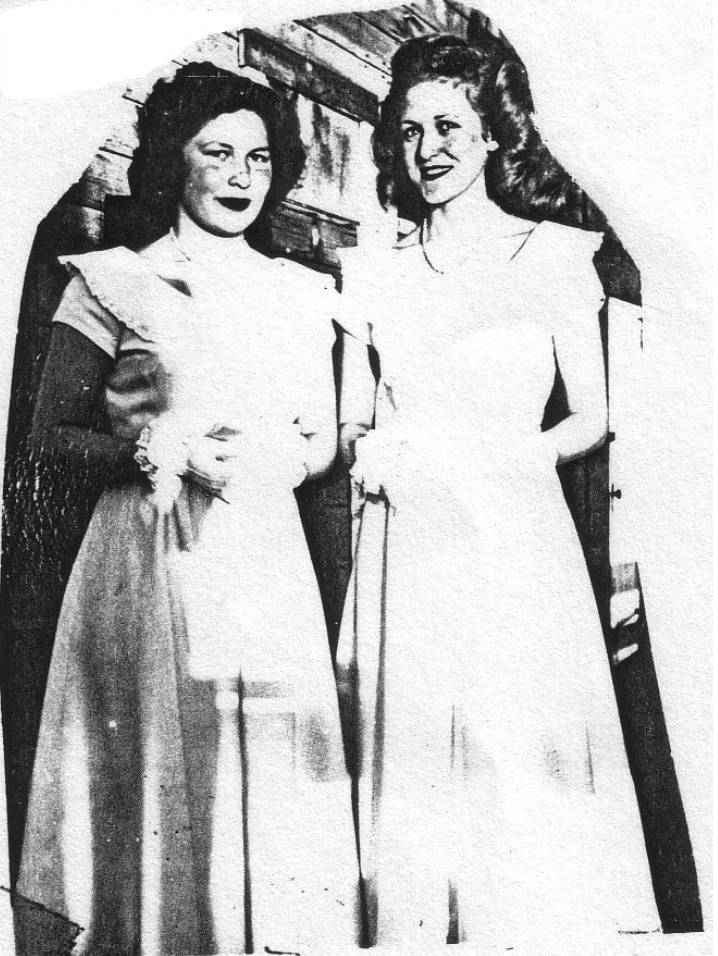
Warts. Mom always took our warts off. Once when I had several warts on my hand, Mom had me get a spool of silk thread. She then put the thread around my warts, said some hokus pokus, then went out and buried the thread. She said that if I found the thread, the warts wouldn’t go away. At first I looked a little for the thread, but was afraid that if I found it, like she said, the warts wouldn’t go away. They did disappear in a few days.
Bachelors. A few more bachelors lived nearby, on either side and down from us. The man next to us had a huge yard all fenced in with poles on top that kept us busy walking Olga Nelsen, Norma Swain. and running the fence barefoot, playing catch me if you can. If you didn’t fall off you were lucky.
Mr. Rosenbush, who was Betsy’s father, lived below us. He would call “Mayonnaise, would you go to the store for me?” I’m not sure if he know that my favorite sandwiches were mayonnaise or that it was because my name, Mae Annette, was so close to the word mayonnaise.
Next to him was another bachelor who had two goats. Once when he was going to be gone for a couple days, he asked May Joyce and me to milk his goats. We didn’t know anything about a goat, let alone how to milk one. The only animals that we were around were bears. Well after a long struggle we caught the two goats and tied them up feet and all. We weren’t sure at the time which one we should milk. I still don’t remember getting any milk from them and we were both scared of them because they kicked.
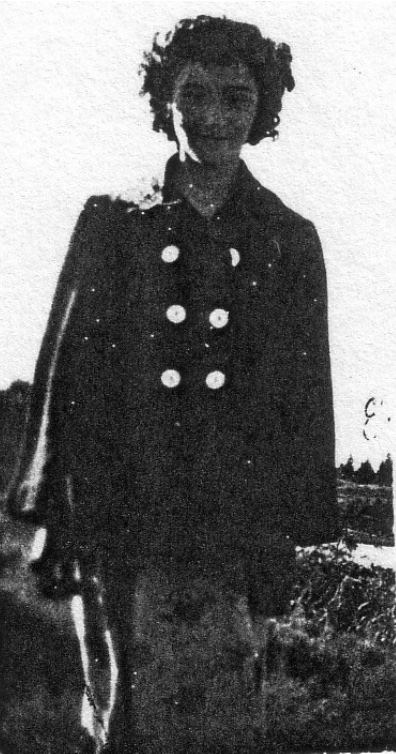
Meehan Family. Up on the left of our house was the Meehans; Pauline was my age. Later when they moved, the Murphy family lived there, after their house burned. I took care of their daughter Carlene. She was such a good little girl, except she didn’t like it when I took her home and gave her baths.
Elvsaas Family. Down our dirt road lived the Elvsaas family, Suzanne, Peter, Fred, Allen, and Petrina. We always fought with them. Once I was screaming at Fred down the hill, “I hate you; I’ll never marry a Fred.”
Nelson Family. Later the Nelsons moved in—Tom, Charlie Boy, Olga, Annie, Herman, and Gustav. We played cards a lot with the boys. I loved pinochle and was a good player so the boys didn’t mind me playing especially when Mae Annette Fox Sharp they needed an extra player. They didn’t like me to win too much either; my brother Tom would get very upset if I won too many games. He even kicked a bench over once when I wouldn’t quit winning.
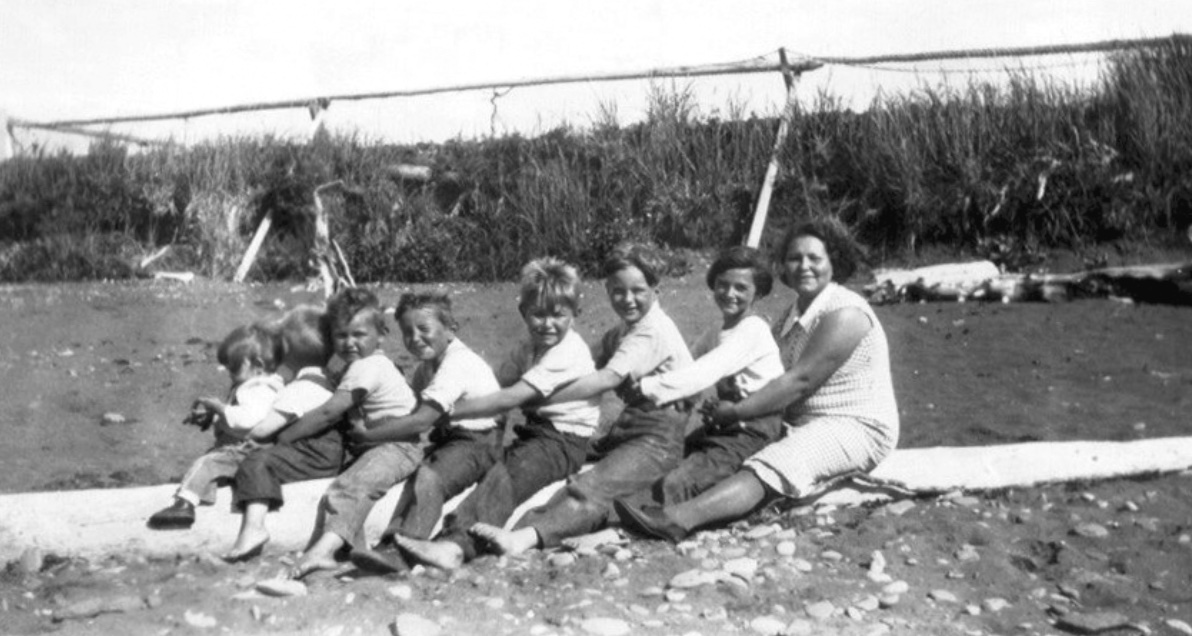
Harris Family. Esther Harris and her family lived in the house when the Nelsons left. She was a good friend of the family and we always had lunch together when we worked in the canneries. Usually we had king salmon head chowder or fried fish. She had several children, including Alice.
Lund Family. Across the road and up the hill was the Lund family. They were older than we were and they played with the Josephson kids and liked to pick on us. Once the Josephsons’ dog bit our dog, and my brother Coogan caught their big black and white dog and bit it on the leg.
McMeekan Family. On up the road lived the McMeekans. Hannah and I competed in a lot of races on the 4th of July. I don’t think either of us liked to lose. She had a brother, Louis, who walked in his sleep, even on the boat. I always wondered why he didn’t walk overboard. Alice and Pauline were the younger girls, and Elizabeth the oldest. The house they lived in had been the Beaches’ first and they had lived further up the slough before that.
A little old lady lived next to them and we would bring her flounder to eat. We didn’t eat them ourselves and thought it was funny that she did. I have eaten them since but still don’t care for them as they are too dry.
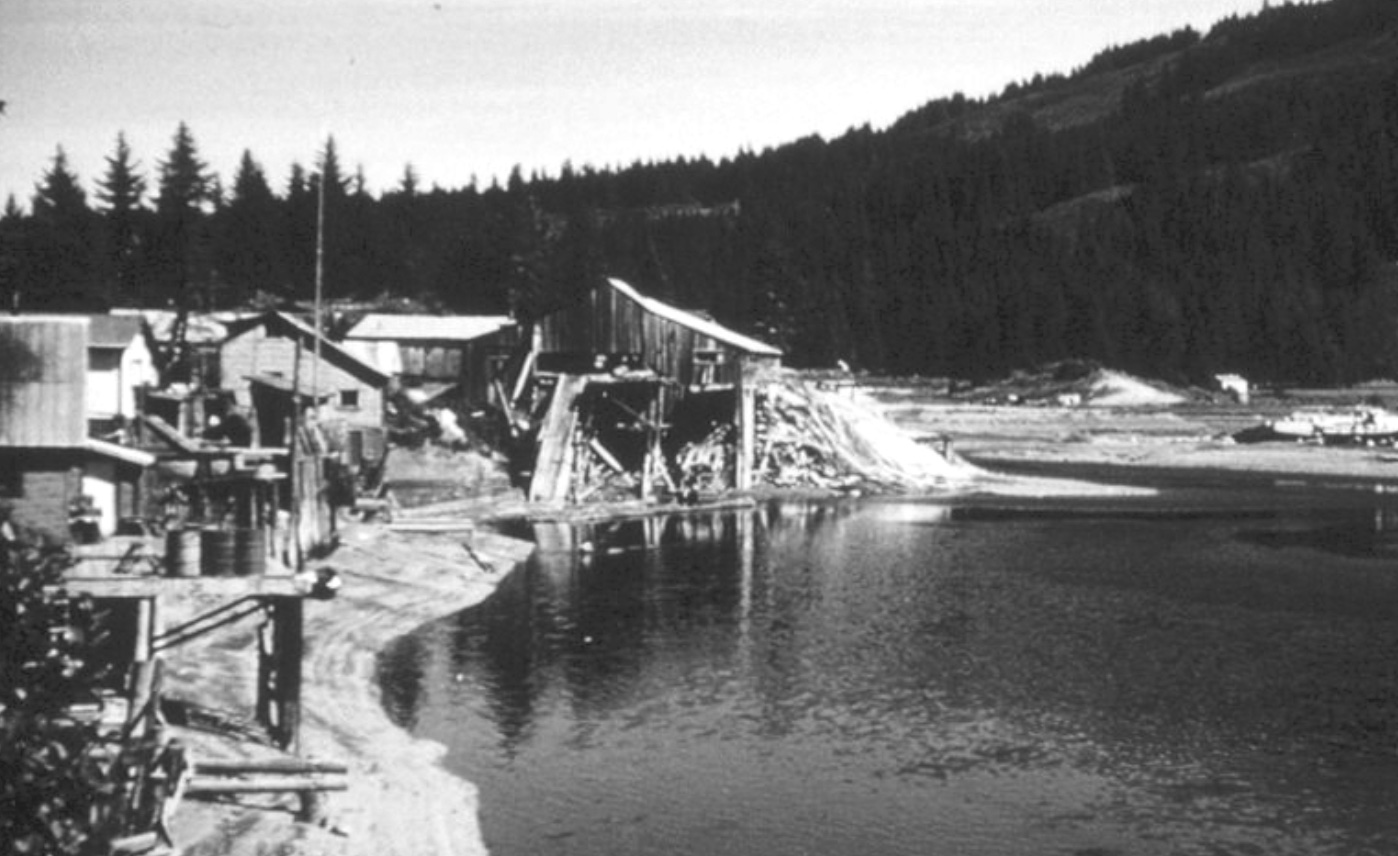
Sawdust Pile. Next was the sawdust pile near the mill. It was a great place to play. The girls liked the swings, but the older boys dug out rooms under the sawdust, and even had bunks carved in the rooms. I looked in once, but was afraid that if anyone walked above, the place would cave in. One time several of us were swinging on the swings near the sawdust pile when three bears came walking down a trail toward the swings. Instead of running home and getting help, we just started yelling at them and chased them back in the woods. To this day it is hard to believe that we got away with some of the stunts we pulled when we were young.
Murphy Family. The Murphy family had the saw mill and later the son Dave ran the mill. We would run all over in the mill when it wasn’t working and we would walk on the logs that were in the water. None of us was ever hurt playing on the logs.
They had a cute little girl named Cookie. Their house caught fire one night while the girl was in the crib and the house burned so fast she couldn’t be saved. My mother was working at the restaurant in town when someone told her that a house up the slough was on fire. She ran all the way home and collapsed when she found that it wasn’t her house.
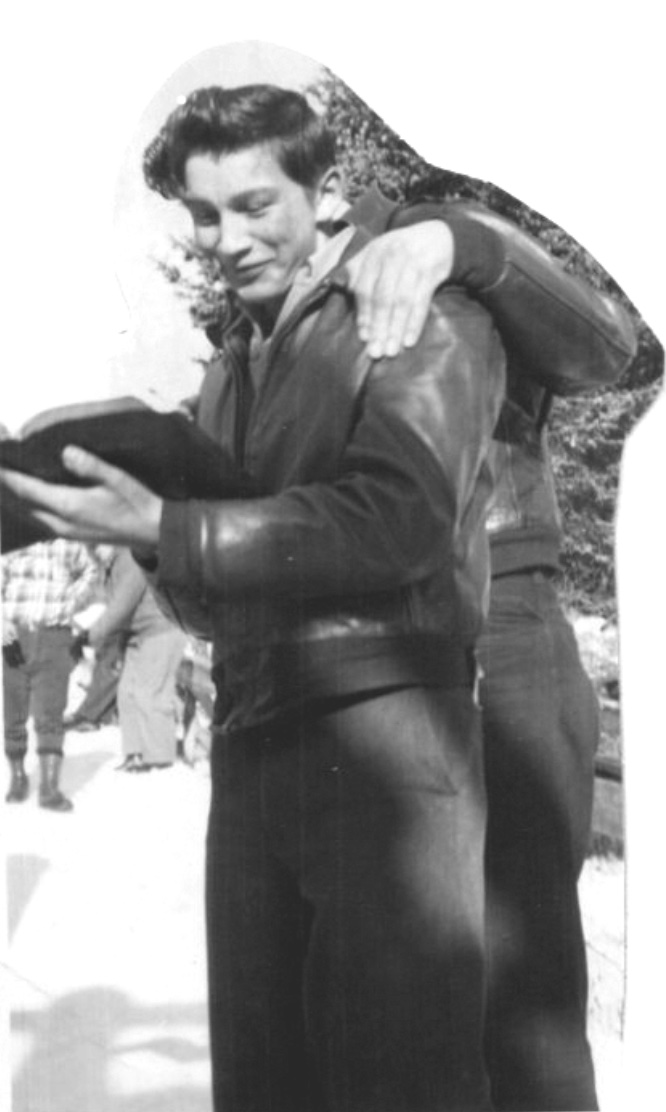
Slough. When the tides were out, salmon would come up the slough in the shallow water. I once tied my dress belt on the tail of a salmon and let him loose. I always watched to see if he would come back.
One of the boys had a dog named Prince. As soon as the tide would go out, you would see him chasing fish up and down the slough. He loved to catch fish and it was fun to watch him from our kitchen window. When the fish were coming up the slough and the tide was real low, you would see several of us in the water trying to catch the fish. As they came down a small stream, we would be busy damming up the stream so the fish couldn’t get away. As small as some of us were, we never seemed to get hurt. As long as Prince fished, I think we all felt safe. I don’t know who had the most fun—the dog or us.
Skating. Near the sawdust pile was our lake, and in November the skating started. In November the weather was the best for skating, not too cold and the ice was better when it was a little soft, and there wasn’t much snow yet. The younger kids skated during the day and at night José Carlough. the teenagers came out. I loved to ice skate. I had black skating pants and a big red sweater that someone gave my brother and he wouldn’t be caught dead in. I thought I looked neat with a white blouse under the red sweater. I think I wore it all the time while skating. Clothes were pretty scarce in our poor family.
We would build a big bonfire at night, skate, and sing around the fire. We would play crack the whip and for some reason I always ended up on the end of the chain. We had several six-foot guys and they would swing me and let me go. I think I would fly at least fifty miles an hour. Once while skating up at Twin Lakes, José Carlough and I were skating full speed. (He always danced and skated full speed so he was a good partner for me.) He was small so could really fly. We were going so fast when someone on the hill by the fire called us and we both put on our brakes and stopped with a dead stop, and as we did I fell over on my bottom and think I cracked my tail bone. It hurt for years, especially when I was pregnant.
I only remember swimming once in the lake and that time we had leeches on us so never did it again. It was terrible picking those leeches off each other.


We usually had a lot of snow, but one year it really got cold. The water froze in the bay and the boys said that you could walk across it. We could skate in the slough. The ice piled up along the shores. I don’t remember a lot of rain; only it seemed to rain a little at night, then the day was clear.
Cemetery. Further up the slough were a few more families, then the newer cemetery where my grandparents were buried. My grandmother had been buried in the old cemetery and was later moved after the big earthquake when the ground sank, and the water came up over it. It must have been quite a chore moving those rotting coffins, as they were all built of wood. There is a spruce tree between the two graves of my grandparents Andy and Hattie Johnson, which is near the gate next to the fence. I don’t know where my great grandmother is buried, as she had been buried in the old cemetery, probably next to Bill Rhodes’ grave site.
Outside Beach and Twin Lakes. Up further was the Outside Beach, which was on Cook Inlet. This was a beautiful place to picnic and walk. Near the beach were Twin Lakes. In the winter we would all go ice skating. It was quite long as the two lakes were connected. In the summer we swam in the lake, but I was really scared as I always had the feeling that someone would grab my feet. I was told that there was no bottom to the lake and if you went under you might get sucked into Cooks Inlet. Only one boy drowned in the lake. My cousin Carmen Olssen tried to save him, but he kept pulling her under and she couldn’t hold him. His name was Cricket; he had moved to Seldovia when I was in my teens.
On up the beach was Barbary Creek. We would find wild strawberries on the hill there. Up further was a huge barn that was torn partly down and this was where people left old trunks of clothes. It was fun scavenging through the things, although we never carried anything home as it was too far to carry anything. On the hill they had a huge abandoned strawberry garden and we spent many summers picking berries there. We would get big buckets full and we didn’t mind carrying them home.
We picnicked a lot on the Outside Beach not only in the summer, but also in the winter. There would be snow all around except on the beaches, and with a big fire going and all the wood you could burn, we would tell stories and gossip around the bonfire. The kids always asked my mother to come on our summer picnics when it was daylight all night. She was the one that brought all the food. She didn’t mind it when the boys would grab her and dunk her in the water.
One Thanksgiving night a bunch of us teenagers decided to go on a hike to Outside Beach. We raided our parents’ kitchens. I got two pumpkin pies from our house; someone had marshmallows; and we started out. It was a cool night and was dark. When we got to the Twin Lakes area the water was over the road and was icy. The ice wasn’t strong enough so we broke through, getting our feet wet. It wasn’t very deep, so didn’t hurt. What hurt the most was one of the boys stepped into one of the pumpkin pies. When we got home, we went down the boardwalk singing. By then it was pretty light out and there was Mrs. Raby leaning out the window watching us above the store. She probably wished she were young again.
Log House. Behind Morris’s store was our log house that my grandfather Andrew Johnson and my great uncle Rufas Bowen and Charlie Olssen built. Charlie Olssen and Rufas Bowen had horses to pull the logs in from the woods.
Anchorage. I made my first big trip to Anchorage when I was thirteen. I baked cakes, bread, and cookies for my uncle Arne Wick and his crew on his boat the St. George, and he took me to Anchorage to stay with my aunt Sue Haskin, my mother’s oldest sister. It was a three-day trip, going by way of Lake Illiamna to drop off supplies. In Anchorage I got to spend time with my aunt Elsie, mother’s youngest sister, who was visiting from Seattle. She took me to town, but hated to have to cross the streets, because if a car was in sight I wouldn’t cross. I spent a month there but was glad to get back home where I could hike and fish.
Jack Wormonson. A friend and school janitor Jack Wormonson lived near my aunt Barbara and he would cook us unusual dinners. Once he made us a Scandinavian goulash, with mashed potatoes, onions, and canned corn beef. One Halloween night with a gang of kids, we stole chickens (the boys did) from the Morrises’ and he cooked them for us. As we were eating, three ladies came to visit him and even helped eat the chicken. On the way to school the next morning we were busy kicking fresh snow over the chicken blood on the road. Whenever I went to Mr. Morris’s store, he would ask me if I knew who stole his chickens. I was pretty honest but I couldn’t tell him that.
Light Plant. Back of Jack’s house was our back road which led through the swamp and lake. The back road went past the light plant run by the Groodoffs. I had read in an old newspaper that the Halsteads started the light plant before them.
Ollsteads. Up from there were the Ollsteads—Stella, Gilbert, Thelma, Lucille, and Alice. They didn’t have far to walk to school; it was right next door.
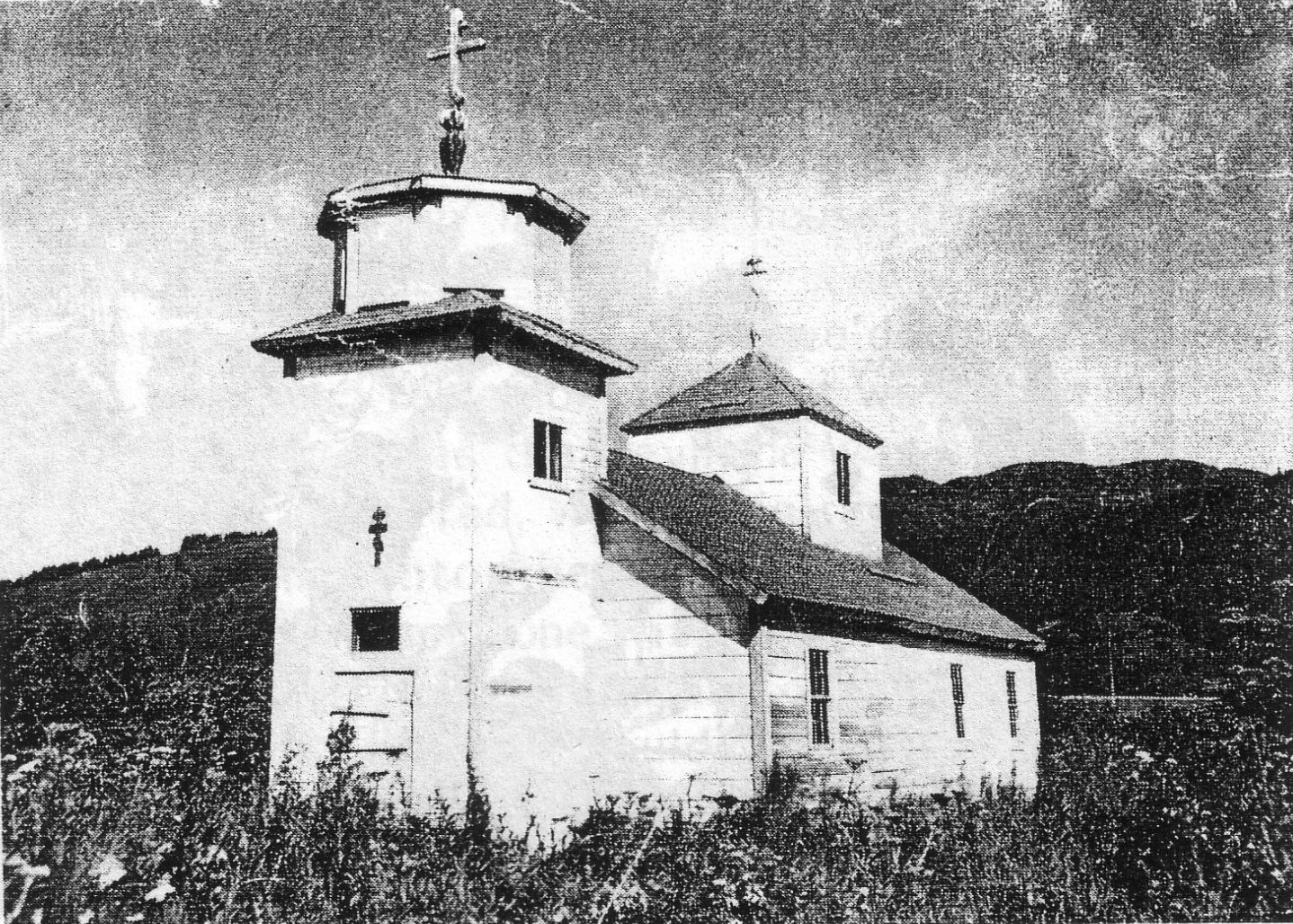
Old Russian Church. We had the old Russian Church. We would go to it on Russian Easter. My grandmother and great grandmother were Russian Aleut and their religion was Russian Orthodox. Once Mary Jensen took Deloris and me to the Russian Church; I think it was Easter. Deloris’s hair caught on fire from my candle, she said. There were no chairs, so we all had to stand. In the front of the altar was a big black coffin and I had to go up and kiss the coffin. It was supposed to be the coffin of Jesus.
Father Shadura would come to have the services in the Russian Church. He had services in many of the other small villages.
Russian New Years was celebrated from January 7th for several days. Russian Aleuts made a huge wooden star on a wheel, and decorated it. It was a double frame that held lighted candles. They would then dress in costumes and go from door to door singing Russian Aleut songs and rolling this star.
The earliest I can remember, I was about three or four years old. My sister was in a crib when dozens of people all dressed up with masks on came in the kitchen. We had a curtain in the doorway from the kitchen to the living room. I grabbed the curtain and hid in it. My sister was in the crib screaming. They were all given treats, usually drinks. I was scared to death until a guy who I remember as Johnny came up to me and I recognized him. You can believe, before they finished going from house to house, they were pretty loaded.
At the end of the old year, we’d have a big dance. The ones I remember the most were when my great uncle Fred was the devil; he was small and was dressed all in red, with a big red pitch fork. He would come into the dance hall every few minutes and grab someone with his pitch fork and try and drag them out of the dance hall. Near the end of the dance someone would catch the devil and drag him out, and then the New Year, usually a young girl who would be dressed in a white crepe paper fairy costume, would come in.
From The Seldovia Herald, 30 January 1930. “Russian Christmas ends with a masquerade dance that draws a big crowd. The last masque ball of the Christmas festival, given at Hill’s Hall the night of Friday 17 January, was attended to capacity and it is improbable that Seldovians have had a gayer evening for a long time. Costumes were attractive, many were unique, while others were doubtless designed for the purpose of getting a laugh, and succeeded admirably.”
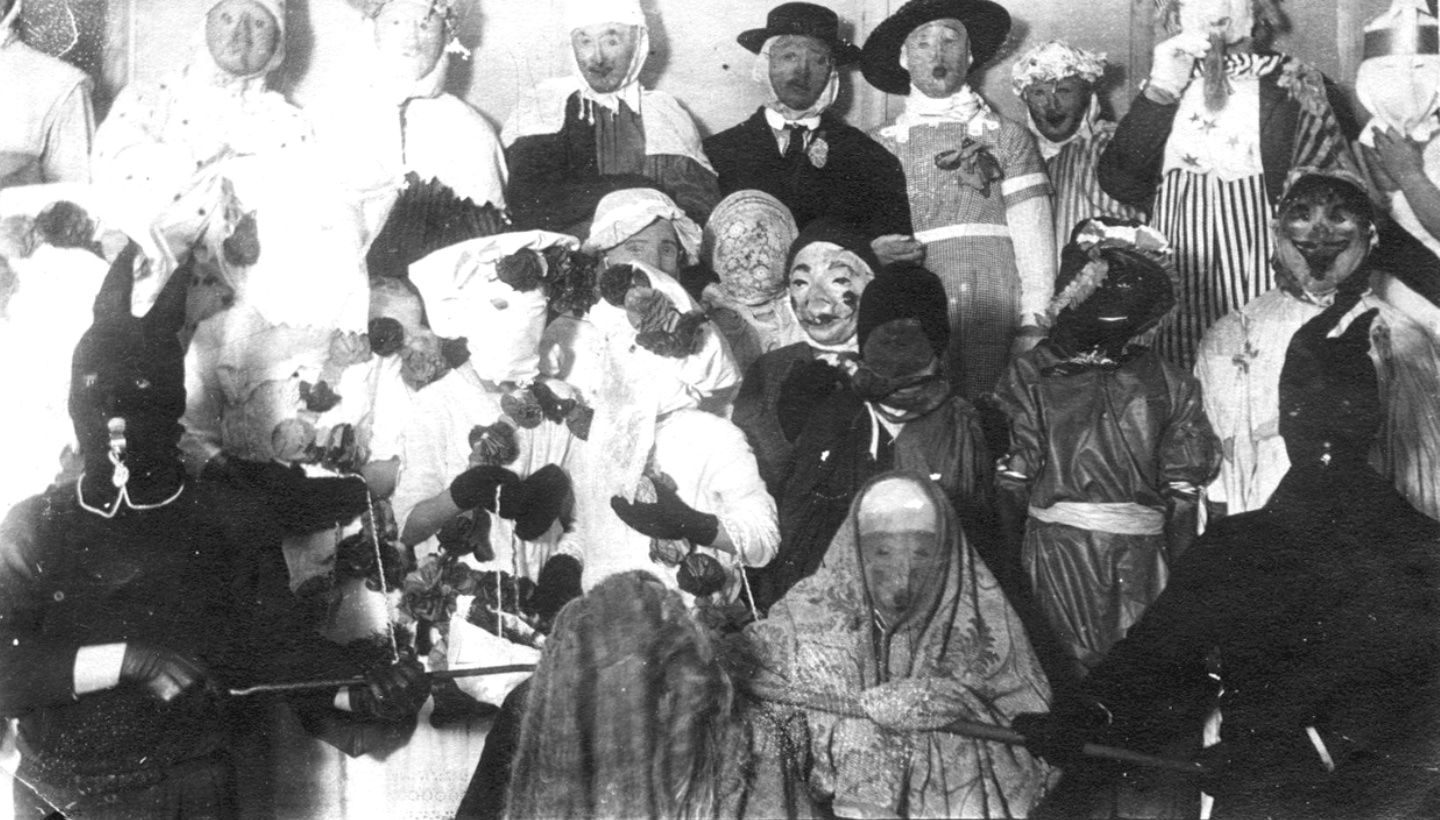
Pea Soup and New Years. I can remember standing around our huge kitchen table eating pea soup on New Year’s Eve. I used to think that we ate pea soup on New Year’s because we were poor, but found out later that it was for good luck. If you ate pea soup on New Year’s you would have good luck all year long. To this day my children and grandchildren laugh at me when I call them and ask them if they have their pot of pea soup on. If not, I’d save them some and even bring it to them so that they could have their good luck the rest of the year.
Easter Sunday. We celebrated Russian Easter Sunday for three days. We rang the church bells steady for the three days. We not only went to our church, but also the Russian Church on this holiday. Mom had ham, potato salad, cakes, and Easter bread called kulich, which was a Russian sweet bread. We would all run up to the house when we were hungry.
Christmas. My mother could never afford to buy Christmas presents for all of us children, but always had a big tree all decorated. I remember some of my great grandmother’s decorations on the tree, especially a basket made of grasses that had a baby Jesus in it. Mother made sure that we went to all the Christmas parties in the town.
All the businesses in Seldovia donated gifts and every child had something nice. There was a sleigh with elves dressed up in green costumes that came to our house. I don’t remember if dogs pulled the sleigh or people did, because we were all too excited to see Santa coming. For all I knew it was Santa’s reindeer pulling the sleigh.
I remember some of us getting skis, sleds, and skates. Someone even brought me a bicycle once. I think that I was seen too often with my brother’s big bike. I was too small to sit on the seat so had to sit on the bar and pedal. The tires were mostly tape. One time I was coming home from the dock and I noticed my tire had a pink bulge showing through. As usual I carried tape, so stopped and took the old tape off, ready to put on new tape when it exploded in my face. I was a little embarrassed as people were looking, and I felt pretty dumb.
My aunt Elsie, who lived in Seattle always sent my sister and me a doll for Christmas. As usual we always peeked in the packages as soon as they were put under the tree. One Christmas my package had a beautiful doll all dressed in blue and lace. As soon as I opened the package on Christmas morning, I grabbed my doll and ran down the hill to Jeanette Vinburg’s and traded dolls. She had an old doll which I loved and she was glad to get the new one. I gave it to Annette Harris when I was in my late teens, and always wish I still had it.
Our school and church had Christmas plays put on by all the children and the whole town came to see them and to sing Christmas carols. When Joe Hill had his hall, it was a big affair, with gifts and apples and candy given to everyone.
I don’t think that any of us six children ever felt poor or left out of anything. Even when I was in my teens and got hand-me-downs from others, I was so glad to get them and appreciated all that I got.
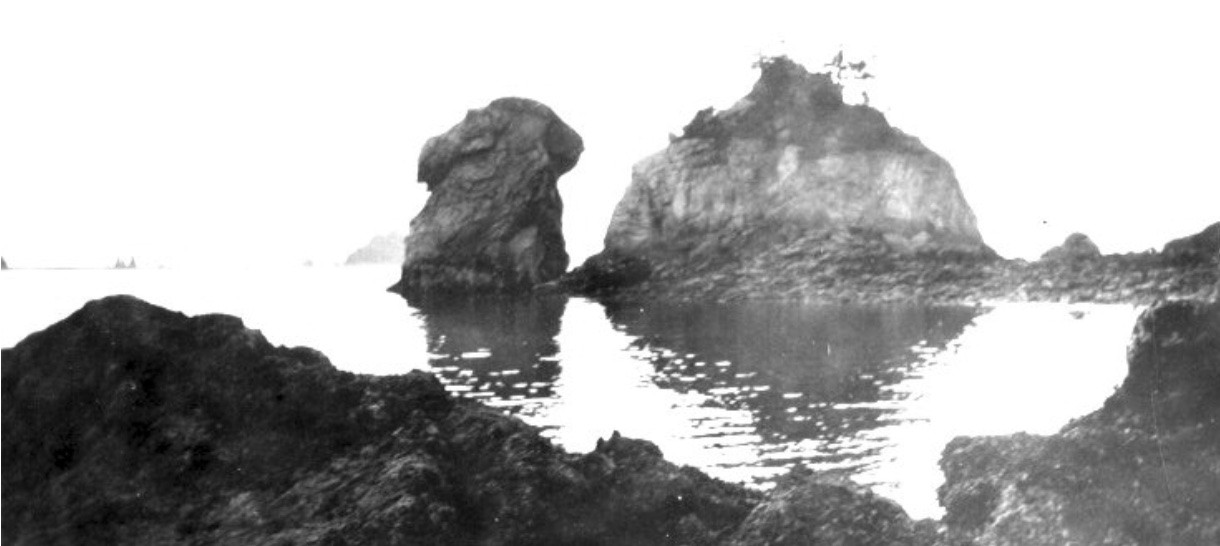
Camel Rock. Camel Rock was just a ways up the Outside Beach side. You followed a trail up along the beach to get to it. The only way you could get to the base of the camel was at a very low tide. I don’t think anyone ever climbed it. It was quite a sight to see as the boats came into the bay from Homer or English Bay.
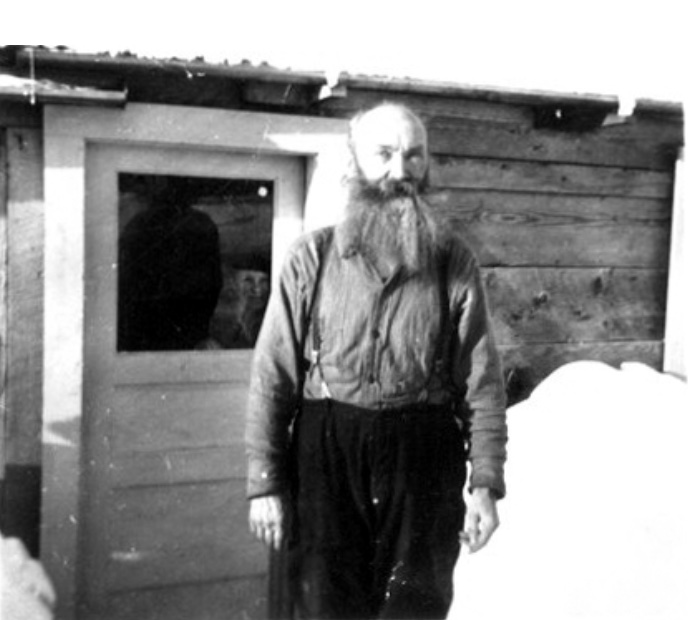
Hoen. Across the bay lived a bachelor named Hoen. He was from Sweden or Norway. We had a lot of beach parties with the families on his beach. It was the best place to dig clams. A clam bake over there was great. They would build a big bonfire, and put a huge wash tub filled with water on the fire, and dump the clams in, shells and all. When done we would fish them out and eat them out of the shells. Hoen also had a good garden. He would tell us stories. He said that at night when the moon was full he could see Indians carrying buckets coming from the hills down to his beach for clams.
Later a man from town built a house way up on the bluff that we called the glass house. I think he worked at or owned the oil company in town. No one lived in it and the kids from Seldovia would row over there and go in the house. I went once and saw where he had built the pantry over the cliff and the kids couldn’t break down the door to get in, which I’m pretty sure they tried, but you could see through a side window that it was full of goodies.
Along the beach from Hoen’s were a couple old summer houses where people from town had set net sites on the beach. I believe the Rosenbush and Yuth families had fish sites there in the early years.

School. Our school was on a hill overlooking the dock. You had to climb several steps to get to the main door. It had four large rooms on the main floor, an office, a furnace room downstairs that had a ping pong table in it, and the kitchen which was used as our science room and later as our high school. We also had a gym where we played volleyball and basketball, and had our school plays and dances.
The clothes that we wore to school were always dresses and white pinafores over them. We wore cotton bloomers, which were sometimes black. The boys wore the usual shirts and pants. There weren’t any blue jeans for girls.
When I was about five years old, we were going to a school picnic. I remember standing on top of a chair in the kitchen screaming blue murder because my mother was trying to get my brother’s blue jeans on me. I don’t think my mother got them on me because I remember going in the back of Ed Danielson’s old pickup in a dress and a white pinafore. For years I had a phobia against blue jeans and never liked to wear them anywhere.
When we had school plays, everyone from town came to see them. We went all out with full costumes and all the trimmings. We had a play for every holiday. My mother was always making crepe paper fairy costumes for the Christmas plays. I was a fairy one Christmas and was so embarrassed when I put on my fairy dress with the gold trimmed wings and you could see right through the dress to my black bloomers.


Mumps, Measels, and Chicken Pox. When any of us got mumps or measles when we were young, we were confined to our homes and a sign was put on our door saying that we were quarantined. When I was about thirteen years old I got chicken pox. I couldn’t go to school, but the doctor said that we could play outside. Annie Nelson had them at the same time so we made a snow house, then skied past the school while it was going. The other kids were so upset with Annie and me, even though we had the miserable chicken pox. We had a lot of fun.

Hospital. The hospital was just below the school. It was built after Doctor Kirby. My mother cooked for the people who ran the hospital. They were Seventh Day Adventists and didn’t eat meat. They let me wait on patients there once, getting them water, etc. I was also a patient there once, having my tonsils out. I remember laying on the table and felt like I was going down a long black tunnel and then being brought to in my room, where they were fighting with my sister Deloris who was next. She heard me screaming and refused to come out. She eventually had them out with a big struggle. We got to eat a lot of ice cream, which was quite a treat in those days.
The oil tanks were just below the school. I climbed to the top of them once, because someone said that I would be afraid to do it. It was pretty windy up there, but I made it.
Behind the school lived the Halvorsons. There were several children but I only remember Helen and Annie who was a good friend of my mother.
When they moved, I think our school principal, Mr. Thompson lived in the house, with his wife and son, Jerry. Jerry graduated with Helen Yuth and me. What a big class of three it was.
Down the hill from the school was Mrs. Poncheen’s and Ed Danielson’s. He had the only truck or car in town, and I once rode in it on a school picnic.
Back Road. The back road was fun to walk. I think there was only one family that lived on it and they had a big house. When you walked it, you would see baby animals in the spring. Once we tried to catch baby spruce hens with our berry buckets, but they were too fast.
The spruce hens always scared me. It would be so quiet and all of a sudden you would hear a loud noise and it would be them flying out of the brush.
We would see ptarmigan in the winter on the snow. They were white and hard to see. Once we ran home and got wrenches and anything that we could throw at them, but our aim wasn’t too good, because we didn’t hit any of them.
There were all kinds of berries along the roads, nogoonberry, which we called swamp strawberries or cloudberries, salmon berries, swamp blueberries, and regular blueberries, currants, and a lot of moss berries.
If you kept on going you would come to my great Auntie Florence’s house, which was a complete circle, or straight you would get to Camel Rock.


Methodist Church. Our church was the Methodist and it was above Charlie Sharp’s store. We had Sunday school, and children’s groups at the church. Later the Toblemans moved to town and had Bible classes for the girls. I guess the boys were too busy. The Toblemans had two girls—Marie, who I believe was the oldest and who played piano, and another little one who was the tomboy of the family.

Jensen Family. Up from Auntie Florence’s was a big house that the Jensens lived in. Viola and Buddy were the only children. Viola had parties now and then. I loved her big covered porch that ran all around her house.
Petersons and Nimons. The Petersons and Nimons lived up further, Florence, Barbara, Margie, Freda, DeDe, and Coogan. I would visit Mrs. Peterson with my mother. I liked to visit these older ladies as they always gave me a piece of crochet doily that they were going to throw away. Sometimes I’d see a doily in the garbage that they threw their threads into and drag a partially finished doily out, and was told that I could have it. Looked great to me and I never refused any of them.